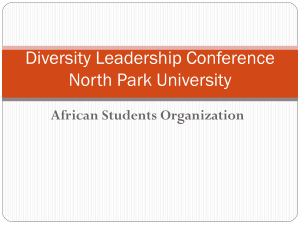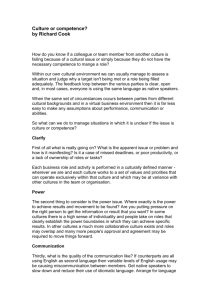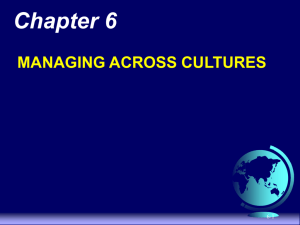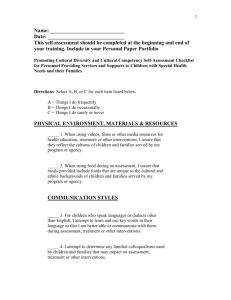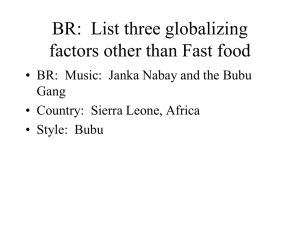Global Pathways Cultural Competence Curriculum Module COLLEGE OF EDUCATION & BEHAVIORAL SCIENCES
advertisement
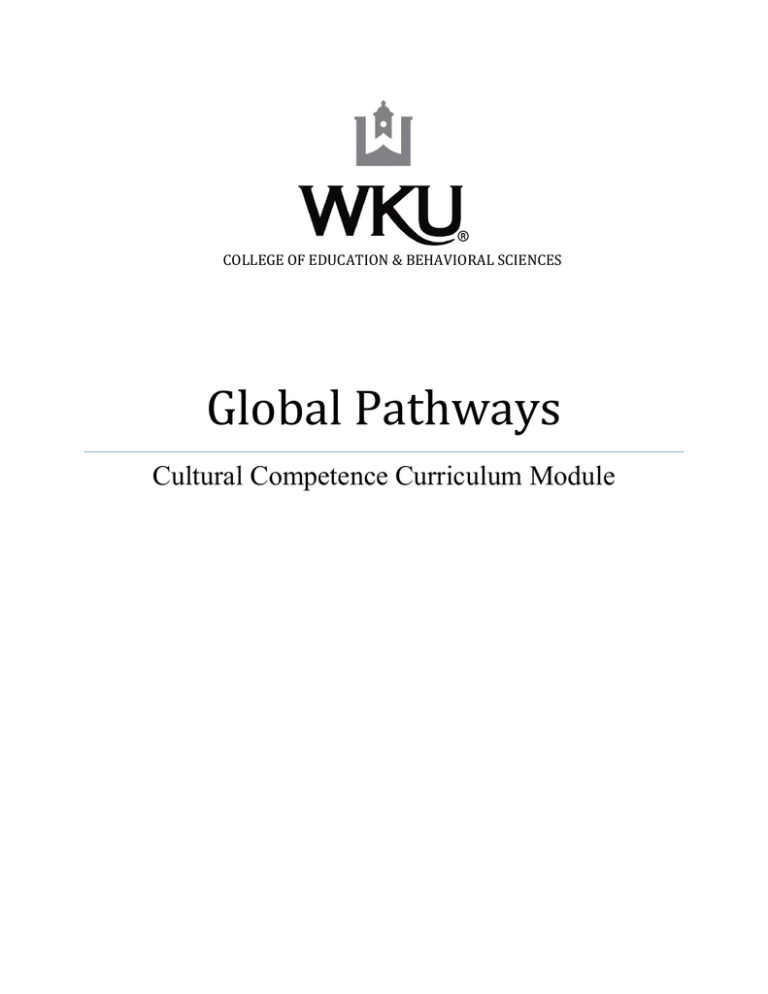
COLLEGEOFEDUCATION&BEHAVIORALSCIENCES
GlobalPathways
Cultural Competence Curriculum Module
Curriculum Module 2 Preface
Thesecurriculummaterialsprovideabasicintroductiontoexistingknowledgeregarding
culturalcompetence.Theyaredesignedtoprovideinstructorswithaccurateinformation
thatcaneasilybeintegratedintoexistingundergraduateandgraduate‐levelcourses,
includingcoursesinpsychologyandeducation.Insodoing,itishopedthatthesematerials
willenhancethequantityandqualityofglobalizationandtheculturalcompetence
frameworkcontentinexistingcourses,sothatstudentscanbebetterpreparedforthe
intellectualandsocietalchallengesfacinganincreasinglydiversesociety.
Thislearningresourcewasdevelopedby:
MonicaBurke,Ph.D.
DepartmentofCounseling&StudentAffairs
RicKeaster,Ph.D.
DepartmentofEducationalAdministration,Leadership,&Research
HidekoNorman,Ph.D.
DepartmentofPsychology
NielsonPereira,Ph.D.
SchoolofTeacherEducation
Curriculum Module 3 Thiscurriculummoduleconsistsoffivesections.Thefirstsectionprovidesanoverviewof
andarationaleforinfusingculturalcompetenceandculturalquotientintoacurriculum.
Sectiontwooutlinestheobjectivesofthecurriculummoduleanddefinitionsoftermsand
conceptsfordiscussion.SectionthreepresentssamplesyllabifromtheDepartmentof
CounselingandStudentAffairsandEducationalResearch.Inaddition,samplecourse
modulesfortheDepartmentofPsychologyandtheDepartmentofTeacherEducationare
provided.Theseillustratevariouswaysinwhichyoucanincorporatetheglobalizationand
culturalcompetencecontentintoacourseinyourdepartment.Sectionfourprovides
examplesofin‐classactivitiesthatwillpromotediscussion.Sectionfiveprovidesa
referencelist,anannotatedbibliographyofsuggestedreadings,alistofavailable
audiovisualmaterialswithdescriptions,andalistingofwebsitestoassistwiththe
developmentofcoursecurriculum.
Instructorsareencouragedtoadaptthesematerialsasappropriatetotheirspecificneeds.
Thematerialsandinformationcanbeusedasasourceoflecturematerialorinstructors
canassignsectionsforstudentreadinganddiscussion.Thesematerialsalsomaybeuseful
asbackgroundreadingforstudentsandfacultynewtothistopic.Itishopedthatthese
materialswillinspireanincreasedawarenessinandknowledgeaboutglobalizationand
culturalcompetence.
Curriculum Module 4 TableofContents
SectionI:
DefiningCulturalCompetenceandCulturalQuotient………………………... 5
SectionI:
RationaleCurriculumInclusion……………………………………………………….
6
SectionII:
CourseModuleGuidelines,Terms&Concepts…………………………………
7
SectionIII: SampleSyllabi:
DepartmentofEducationalAdministration,Leadership&Research…..
SyllabusforCNS581‐InternationalStudentServices
DepartmentofCounseling&StudentAffairs……………………………………...
CulturalCompetenceCurriculumModule
DepartmentofPsychology……………………………………………………………….
TeacherEducationModule
DepartmentofTeacherEducation……………………………………………………
CourseModule:CulturalAwareness&InterculturalDialogue
DepartmentofMilitaryScience…………………………………………………………
10
13
18
21
30
SectionIV: In‐ClassActivities:BookResources…………………………………………………... 35
ClassroomAssignments…………………………………………………………………… 36
SectionV:
Resources:
Books……………………………………………………………………………………………..
40
Teaching/Curriculum(Books)…………………………………………………………
42
ShortStories…………………………………………………………………………………..
43
MediaResources:Video/Documentaries…………………………………………. 44
MediaResources:Movies………………………………………………………………..
46
WebResources………………………………………………………………………………
48
Appendices
PowerpointPresentation……………………………………………………………….
49
CaseStudyDiscussion:Nacirema……………………………………………………
59
Culturaltests/Assessmenttools………………………………………………………. 64
Curriculum Module 5 CulturalCompetenceCurriculumModule
CollegeofEducationandBehavioralSciences
SectionI
DefinitionsofCulturalCompetence
CulturalcompetenceisthesocialawarenessthateveryoneisnotlikeIam,thattheir
differentculturesandbackgroundsaffecthowtheythinkandbehave,andthatthis
awarenessallowsmetobehaveappropriatelyandperformeffectivelyinculturallydiverse
environments.
“Culturalandlinguisticcompetenceisasetofcongruentbehaviors,attitudes,andpolicies
thatcometogetherinasystem,agency,oramongprofessionalsthatenableseffectivework
incross‐culturalsituations.”(U.S.DepartmentofHealthandHumanServices–Officeof
MinorityHealth)
“Culturalcompetencereferstoanabilitytointeracteffectivelywithpeopleofdifferent
cultures...andcomprisesfourcomponents:(a)awarenessofone'sowncultural
worldview,(b)attitudetowardsculturaldifferences,(c)knowledgeofdifferentcultural
practicesandworldviews,and(d)cross‐culturalskills.Developingculturalcompetence
resultsinanabilitytounderstand,communicatewith,andeffectivelyinteractwithpeople
acrosscultures.”(http://en.wikipedia.org/wiki/Cultural_competencecitingMartin&
Vaughn,2007–seenextdefinition)
“CulturalCompetencyisdefinedasintegratingthefollowingintoaninstitution'scultural
fabric:awareness,attitude,knowledgeandskillssurroundingdifferentracialandethnic
groups.”
Martin,M.&Vaughn,B.(2007).StrategicDiversity&InclusionManagement
magazine,pp.31‐36.DTUIPublicationsDivision:SanFrancisco,CA.
Culturalcompetenceisasetofcongruentbehaviors,attitudesandpoliciesthatcome
togetherinasystem,agencyoramongprofessionalsandenablethatsystem,agencyor
thoseprofessionstofunctioneffectively.Fiveessentialelementscontributetoasystem’s,
institution’s,oragency’sabilitytobecomemoreculturallycompetentwhichinclude:
Valuingdiversity
Havingthecapacityforculturalself‐assessment
Beingconsciousofthedynamicsinherentwhenculturesinteract
Havinginstitutionalizedcultureknowledge
Havingdevelopedadaptationstoservicedeliveryreflectingandunderstandingof
culturaldiversity
Curriculum Module 6 Thesefiveelementsshouldbemanifestedateverylevelofanorganizationincludingpolicy
making,administrative,andpractice.Furthertheseelementsshouldbereflectedinthe
attitudes,structures,policiesandservicesoftheorganization(Cross,Bazron,Dennis,&
Isaacs,1989).
Cross,T.,Bazron,B.,Dennis,K.,andIsaacs,M.(1989).Towardaculturallycompetentsystemofcare
(Vol.1).Washington,DC:GeorgetownUniversity.
CulturalQuotient(CQ)
CulturalQuotient(CQ)helpsusunderstandandcommunicatewithpeoplefromother
cultureseffectively.Itisone’sabilitytorecognizeculturaldifferencesthroughknowledge
andmindfulness,andbehaveappropriatelywhenfacingpeoplefromothercultures.The
culturalintelligenceapproachgoesbeyondthisemphasisonknowledgebecauseitalso
emphasizestheimportanceofdevelopinganoverallrepertoireofunderstanding,
motivation,andskillsthatenablesonetomoveinandoutoflotsofdifferentcultural
contexts(Ang&VanDyne,2008).
Ang,S.,&VanDyne,L.(Eds.)(2008).Handbookonculturalintelligence:Theory,measurementand
applications.Armonk,NY:M.E.Sharpe.
Duetotheglobalizationofourworld,peopleofdifferentculturestodaylivetogetherin
communitiesacrossourmanynations.Thispresentsmoreopportunitiestointeractwith
diverseindividualsinmanyfacetsandthus,today’sworkforcewouldneedtoknowthe
customsandworldviewsofothercultures.Therefore,peoplewithahigherCQcanbetter
interactwithpeoplefromothercultureseasilyandmoreeffectively.
ThemostimportantreasonforunderstandingCQisthatCQisacriticalcapabilitythat
enhanceseffectivenessinculturallydiversesituations.Forexample,CQ(1)enhances
sensitivitytoculturaldifferences;(2)reducesuseofoverlysimplisticstereotypes;(3)
enhancesadjustmentandrelationshipsinmulti‐culturalcontexts;and(4)improves
decision‐makingandworkperformanceinmulti‐culturalcontexts
(http://www.culturalq.com/benefitscq.html).
RationaleforCurriculumInclusion
Ourcountryandourworkplacesettingsarebecomingmoreandmoreculturallydiverse.
Additionally,interactionwithindividualsandgroupsfromothercountriesandcultures
eitherface‐to‐faceorinvirtualcontextsismorecommonplacethanever.Effectiveworking
relationshipsprovideforproductiveoutcomes(e.g.,products,services).Forgraduatesof
WKUtobesuccessfulintheirfuturecareers,itisnecessarythattheybeexposedtoothers
whoareculturallydiverseandthattheyengageindiscussionsandactivitiesthathelpthem
notonlyeffectivelyfunctioninthosesettingsbutactivelycontributetothosepositiveand
productiveoutcomes.
Curriculum Module 7 SectionII
UnitDescription
Inthisunit,studentswillexamineglobalization,itsmanyfacets,complexities,paradoxes,
andcontroversies,especiallyastheseaffectthemissionandworkofauniversity.Theunit
intendstomovethestudyofglobalizationbeyondtheclassroombyextendingactivities
intothecommunityandaroundtheworld.Studentswillalsorefinetheirtheoretical
understandingofglobalizationbystudyingitsconcretemanifestationsinvariousareas
(e.g.,counseling,studentaffairs,psychology,teachereducation,educationaladministration,
andmilitaryscience).TheimpactofglobalizationonthefutureofWKUwillbeemphasized
(Lake,2007).
Objectives
Atthesuccessfulconclusionoftheunit,thestudentswillbeableto
demonstrateanunderstandingofdiverseinterpretationsofglobalization;
identifytheopportunitiesandbenefitsofglobalizationandthewaysthesecanaffect
themissionandworkoftheuniversity;
articulatewhatitmeanstobeagloballycompetentlearner;
defineculturalcompetence;
articulatetheroleofuniversitiesinshapinggloballycompetentlearners;and
elaborateontheuneven,unintended,andcomplexrelationshipofglobalizationon
educationandeducationsystems.
Definitions
Bicultural:Apersonwhoiscompetentintwoculturesandeducationalprogramsthat
recognizethevalueandworthofboththedominantcultureandcultureofastudent’s
family,enhancingthedevelopmentormaintenanceofapositiveself‐image.
Bilingualism:Theabilitytofunctionintwolanguages.Whilesomecontendthat
bilingualismimpliesnative‐likefluency,othersmeasurecompetencyintwolanguagesas
adequatetobeconsideredbilingual.
Colorblindness:Claimthatonedoesnotseeaperson’sraceandtreatseveryoneequally
regardlessofrace.
Culture:ablueprintthatdetermineshowwethink,feel,andbehaveinsociety.Culture
providesacceptedandpatternedwaysofbehaviornecessaryforpeopletolivetogether.
Cultureimposesorderandmeaningonourexperiences.Withineachcultureare
individuals,whoareuniqueexpressionsofmanyculturesandsubcultures.
Curriculum Module 8 CulturalBias:interpretingandjudgingoccurrencesintermsparticulartoone'sownculture.
Enculturation:Processofacquiringthecharacteristicsofagivencultureandbecoming
competentinitslanguageandwaysofbehavingandlearning.
Acculturation:Theprocessofassumingnewwaysandbehaviorsofaculturethatis
differentfromone’scultureoforigin,whileretainingsomeofthebeliefsandattributesof
one’sownculture.
Ethnocentrism:Viewthatone’sculturalgroupissuperiortoallothers.
Globalization:Asystemthatconnectscountrieseconomically,politically,environmentally,
andculturallythroughaglobaleconomysupportedbyfreetrade,international
corporations,andworldwidelabormarkets.
Individualism:Referstotheattitudeofvaluingtheselfasaseparateindividualwith
responsibilityforone’sowndestinyoractions.Forexample,takescareofownneedsover
thegroup,self‐interestisanappropriategoal
Collectivism:Emphasizescommoninterests,conformity,cooperationand
interdependence.Forexample,takingcareofthegroupneedsoverone’sindividualneeds
Norms:Rulesandexpectationsforpeople’sbehaviorwithinasociety.
ConceptsforDiscussion(Gollnick&Chinn,2009)
1. Definitionsofferedimmediatelyaboveandthegeneraldefinitionsofcultural
competency.
2. CharacteristicsofCulture
a. Itislearned.
b. Itisshared.
c. Itisanadaptation.
d. Itisdynamic.
3. Fundamentalbeliefsofmulticulturaleducationincludethefollowing:
a. Culturaldifferenceshavestrengthandvalue.
b. Schoolsshouldbemodelsforhumanrightsandrespectfordifferences.
c. Socialjusticeandequalityforallshouldbeofparamountimportancein
curricula.
d. Schoolingcanprovidetheknowledge,skills,anddispositionstohelp
studentsfromdiversegroupslearn.
e. Attitudesandvaluesnecessaryforthecontinuationofademocraticsociety
canbepromotedinschools
4. NewChallengesforEducators
Curriculum Module 9 a. Withthearrivalofeachnewgroup,newchallengesawaiteducatorswho
seektoworkcollaborativelywithfamiliestorespectholidays,rituals,and
customs.
b. Agoalistohelpstudentsaffirmtheirculturaldifferences,whilerealizingthat
theirfellowstudentshavemanysimilarities.
5. OtherSuggestionsforContent
a. TESOL/ESLResources
b. CaseStudies
c. Statistics(e.g.,numberofinternationalstudentsandnumberofnationalities
presentattheWKUcampus)
Curriculum Module 10 SectionIII
SampleSyllabi
______________________________________________
DepartmentofEducationalAdministration,Leadership,&Research
SampleSyllabusActivityforCulturalIntelligenceComponent
______________________________________________
COURSESYLLABUS
EDAD640–IntroductiontoSchoolLeadership
(3CreditHours)
Cataloglisting:Surveycoursedesignedtoprovideafoundationintheconceptsofschool
leadership,especiallyastheyrelatetotheroleofadministratorsinP‐12settings.Field
workconsistentwiththeroleoftheschoolprincipalisrequired.
Coursedescription:Thiscoursewillprovideafoundationforallothercoursesinthe
administratorcertificationprogram.
Prerequisites:Completionofamaster’sdegreeineducation‐relatedareaandadmissionto
theInstructionalLeadership‐SchoolPrincipalAllGradesprogram.
CourseObjectivesandStandards:ThefollowingstandardsfromtheKentuckyCohesive
LeadershipSystemContinuumforPrincipalPreparationandDevelopmentwillbe
addressed:TheDimensionofSecuringandDevelopingStaffincludingthefunctionsofStaff
Selection,PersonnelEvaluation,WorkConditionsandEnvironment,andProfessional
Development;ISLLCandTechnologystandards.(StandardsIndexed–Dimensionsand
FunctionsforSchoolLeaders‐DF;ISLLC‐I;Technology‐T)
(Belowisoneof15objectivesforthecourseandtheonlyonethatrelatestoglobal
learning/culturalquotient–likewisefortheCourseTopicbelow.)
Atthecompletionofthecourse,thestudentwillbeableto:
Demonstrateanunderstandingoftheimportanceofdiversityincurriculum(1.1e)
Curriculum Module 11 CulturalDiversityActivity
Atyourtablescompletethefollowingassignmentgiventhescenarioprovided.
Scenario
Youaretheleadershipteamatyourelementary(K‐5)school(principal,assistantprincipal,
guidancecounselor,andgradelevelchairs).Atthecloseofthepastschoolyear,you
learnedthatyourschoolwillhaveitsfirstwaveofBosnianrefugeesattendingyourschool
thiscomingfall;these30studentswillberelativelyevenlydistributedamongyoursix
grades,withfourtosevenstudentsineachclass.Youraverageclasssizeis25,sothese
studentscompriseapproximately20%ofeachclass.Inthepast,youhavehadnostudents
inyourschoolfromcountriesorbackgroundsotherthantheU.S.Thiswillbeabrandnew
experienceforyourstudents,yourfacultyandstaff,you,andthecommunity.
Plan
Developaplanthatwilladdressthefollowing:
1. Suggestionsfor“educating”yourfaculty/staffoverthesummerconcerningthe
Bosnianculture,howthatcultureisdifferentfromours,andthetypesof
experiencesthesechildrenmighthaveencounteredintherefugeecamps.
2. Suggestionsforcopingwiththechallengesthesestudentswillpresentto
faculty/staffduringtheupcomingyear.Besuretoincludeapproachestoassessment
andanycurricularadaptationsthatmighthavetobemade.
3. Suggestionsforwaystocapitalizeonthis“opportunity”toengagethe
faculty/staff/students/communityindiscussionsconcerningthefollowing:
a. Becomingculturallycompetent(awareandknowledgeableofothercultures)
b. Benefitsofhavingothers“notlikeus”inourmidst
c. Howthisexperienceincreasesourindividual/collectiveworthin
contributingtoaglobalizeworld(beginwithdefiningthephrase“culturally
competent”)
Follow‐upLarge‐GroupDiscussion
1.
2.
3.
4.
5.
Whatdoes“globalization”mean?
Whatdoesitmeantobe“culturallycompetent”?
Whatareourobligationsascitizensinaglobalsociety?
Howdothoseobligationsmaterializeforusaseducatorsinaglobalsociety?
Howcaneducatorsbetterpreparethemselvesforthechallengestheywillbefacing
inthisarenainthefuture?
Curriculum Module 12 Resources(availableintheEducationalResourceCenter[ERC]atWKU):
GlobalPathwaysTitle
Author
InterculturalCompetence:InterpersonalCommunicationAcrossCultures
MyronW.Lusting
Globalization:TheEssentials
GeorgeRitzer
BehaveYourself!:TheEssentialGuidetoInternationalEtiquette
MichaelPowell
Globalization:AVeryShortIntroduction
ManfredSteger
AndrewBain
AYearofFestivals
JamesBainbridge
EssentialDo’s&Taboos
RogerAxtell
TheNewGlobalStudent
MayaFrost
PreschoolinThreeCultures
J.J.Tobin
UnderstandingArabs:AGuideforModernTimes
MargaretK.Nydell
EducatingCitizensforGlobalAwareness
NelNoddings
InternationalizingtheCurriculuminHigherEducation:NewDirectionsforTeaching&
Learning
CarolinKreber
TheSAGEHandbookofInterculturalCompetence
DarlaK.Deardorff
AGuidetoEducationalSystemsAroundtheWorld
ShelleyFeagles
(ed.)
GlobalizationandEducation:CriticalPerspectives
NicholasBurbules
CarlosTorres
Curriculum Module 13 DepartmentofCounseling&StudentAffairs
SyllabiforCNS581:InternationalStudentsandStudentServices
Rationale:
Culturalcompetenceisessentialinanyhelpingprofession.Itallowsprofessionalsto
understandtheimportanceofworkingwithdiverseindividualsinordertoimprovetheir
overallwell‐being.Thefollowingsyllabusprovidesanexampleacoursethatincorporates
globalization,internationalstudiesandculturalcompetence.
Culturalcompetencemayassiststudentaffairspractitionersincreatingdiverseand
inclusivecampuses.AccordingtoPope,Reynolds&Mueller(2004),multicultural
awareness,knowledge,andskillsarecorecompetenciesthatallstudentaffairs
professionalsneedregardlessoftheirjobresponsibilitiesandleveloftraining.Despitethe
philosophicalconnectionbetweenmulticulturalismandthevaluesofthestudentaffairs
profession,manystudentaffairspractitionersandscholarsarenoteffectivelytrainedto
addressthecomplexandconstantlyevolvingculturaldynamicsontoday’scampuses(Pope,
Reynolds&Mueller,2004).Therefore,itisnecessarythatgraduatestudentsinstudent
affairsprogramstoengageinactivities,discussionsandcriticalreflectionstodeveloptheir
culturalcompetence.
CNS581
InternationalStudentsandStudentServices
(Excerpts)
*Thisisanonlinecourse
CourseDescription:
Exploresinternationalstudents’needsandinterestsandglobalissuesconfrontinghigher
education.Focusesonincreasingstudentinterculturalawarenessasafoundationfor
studentservices(domesticandabroad)andstudyabroad.
Purpose:
HighereducationhasbecomeglobalizedresultinginaneedforAmericancampus
internationalizationandattentiontocompetitionposedbyuniversitiesabroadforstudent
enrollments.Trendsindicateaneedforinternationalstudentservicesinallpostsecondary
institutionsaswellasleadershipincampusinternationalization.Recognizingtheunique
contributionofinternationalstudentstothelearningenvironment,studentsinthecourse
Curriculum Module 14 willbepreparedtoprovideservicesandprogramstomeettheequallyuniqueneedsof
internationalstudentsinadditiontoservingcampus‐widefaculty,staff,andstudentswith
educationandprogrammingtobroadencrossculturalunderstanding.
Preparation/PresentationofAssignments
WrittendocumentsmustbeinMSWordfileformat(.doc/.docxextension).Presentations
mustbeinMSPowerpointformat.(.ppt/.pptxextension).SpecialNote:Ifyouareusing
Office2007or2010,pleasesavealldocuments/presentationsin‘compatibilitymode’so
studentswithearlierversionsofWordandPowerPointwillbeabletoaccessthem.Other
filetypeswillnotbeaccepted,asIandothermembersoftheclassmaybeunabletoopen
them.
Reminder:AllAssignmentsaredueby11:59pmondesignatedduedate.
ApplicationstoStudentAffairs.Thefollowingthree(.pdf)documentsareinthe
"CourseDocuments"sectionofBlackboard:
InternationalSkillsandExperiencesforaGlobalFuture
TheSignificanceofInternationalIssuesandResponsibilitiesintheContemporary
WorkofStudentAffairs
ContributionsofInternationalStudentsandProgramstoCampusDiversity
Pleasereviewthesedocumentsanddevelopa(single)PowerPointpresentationthat
summarizesyourreactiontothem.
TheRoleofCulture.Pleasereadthearticle“PositiveAspectsofInternationalStudent
Transitions:AQualitativeInquiry”(foundin“TheRoleofCultureAssignment”folderunder
“CourseDocuments”)andthenreviewthefollowingsevenvideos.Developasingle
PowerPointpresentationthatsummarizesyourreactiontothem.ThisPowerPointshould
bepostedtoTheRoleofCultureAssignmentTabandtoTheRoleofCultureDiscussionBoard.
WhatisAmericanCulture?
http://www.youtube.com/watch?v=pg87sSaTZSc
MostdifficultthingforanAmericanstudenttoadjustto...
http://www.youtube.com/watch?v=‐Vypw1O59u4
Curriculum Module 15 InternationalStudentExperiencePart1:CultureShock
http://www.youtube.com/watch?v=tPfB6GIjM9Q
InternationalStudentExperiencePart2:CultureShock
http://www.youtube.com/watch?v=H82IFq0HbTQ
InternationalStudentExperiencePart3:SocialAdjustment
http://www.youtube.com/watch?v=C7iznNFGzIg
InternationalStudentExperiencePart4:AmericanHandshakes
http://www.youtube.com/watch?v=powo_XwMTZs
InternationalStudentSocialPreparation&OrientationtoSuccessinAmerica(part2/3)
http://www.youtube.com/watch?v=SA9Od5Zxft0
ChapterPresentation/Discussion.Studentswillleadaclassdiscussionoveranassigned
chapterfromthetextbook:
HigherEducationandInternationalStudentMobilityintheGlobalKnowledge
Economy”byKemalGűrűz(StateUniversityofNewYorkPress,2011)
ISBN978‐1‐4384‐3568‐8
Specificchapterswillbeassignedbytheinstructor.TheDiscussionLeader(thestudent
responsibleforpresentingthechapter)willdevelopaPowerPointpresentationover
his/herassignedchapteranduploadittotheChapterPresentation/Discussion
AssignmentTabandtotheChapterPresentation/DiscussionDiscussion.
ThePowerPointshouldbe25‐30slidesandcovertheessentialcontentofthechapter.
Itshouldalsoinclude2‐3discussionquestionsthattheotherstudentsintheclasswill
respondtoontheDiscussionBoard.Thepresentationistohaveallthequalitiesofa
facetofacepresentation,becomprehensiveincoverageofthetopic,exhibitcreativity,
andincludecitationsandreferencesasappropriate.Youareencouragedtoincludeweb
links,videoclips,andothercreativemeanstopresentinformationthroughthe
PowerPointpresentation.
TheDiscussionLeaderwillmoderatethediscussionfortheirpresentation‐‐interacting
withandrespondingtoquestions,responses,andfurtherencouragingthediscussion.
Curriculum Module 16 TheDiscussionParticipantswillrespondtoquestionsinthepresentationusingchapter
informationaswellasotherreading,sources,orexperiences.Themoreinteractiveyou
areinthediscussionthebetteropportunityyouhavetolearn.Youareencouragedto
posequestionsandfullydiscussissuesraisedandideasputforward.
Asareminder:On‐linediscussionisgenerallylooserandmorefreeflowingthanface‐
to‐faceconversation.Everyonewillbeexpectedtoexercisebasicrespectforone
anotherintheseonlinediscussions.
TheDiscussionParticipantswillbeevaluatedforlevelofcontributionandinvolvement
inthediscussiontoearnParticipation/Contributioncredit.
InterculturalSkillsProject.Studentsaretochooseoneofthefollowingthree
Options(activities)thatwillcontributemosttohis/herpersonalandprofessionalgoals
andlearning.
OptionA:AttendandassistwithactivitiesattheInternationalStudentOrientation.
Onceyouhaveparticipatedinthisactivity,pleaseprepareareport(4‐6pages)inwhich
youaddressthefollowingpoints:
1.
2.
3.
4.
Describeyourfeelingsandthoughtsregardingyourexperiencesattheorientation.
Whatdidyoulearnaboutyourself?
Whatdidyoulearnaboutinternationalstudents?
Nametwowaysinwhichyoucanusewhatyouhavelearnedinrelationshiptoyour
personal/professionalgoals.
OptionB:Makecontactwitharefugeecenter,internationalserviceagency,directorof
InternationalProgram(ifnotinyouroffice),orachurchtovolunteertobeabletomeet
andspendsometimeservinganinternationalstudent,family,orindividual.(Thismust
beastudent,family,orindividualyouarenotpreviouslyacquaintedwith).Many
internationalstudentshaveremainedonthecampusduringthebreakoraresoon
arrivingatcampuses.Theymayneedassistancefindingtheirwayaround,visiting
variouscampus/communityoffices,groceryshopping,etc.TheInternationalCenterhas
refugeeswhomayneedsomeonetotakethemgroceryshopping,tovisitthriftshops,or
otherintroductoryexperiencesinthecommunity.
Onceyouhaveparticipatedinthisactivity,pleaseprepareareport(4‐6pages)inwhich
youaddressthefollowingpoints:
1. Describeyourfeelingsandthoughtsregardingyourcrossculturalinteraction.
Curriculum Module 17 2. Whatdidyoulearnaboutyourself?
3. Whatdidyoulearnaboutindividual(s)fromothercountries?
4. Nametwowaysinwhichyoucanusewhatyouhavelearnedinrelationshiptoyour
personal/professionalgoals.
OptionC:Developaprogram,activityorservicedesignedtomeettheneedsofa
specificinternationalstudentpopulation.Aspartoftheresearchforthedevelopment
ofthisprogram,activityorservice,youshouldinterviewandinteractwith
representative(s)oftheinternationalstudentpopulationidentifiedforthisproject.
Onceyouhaveparticipatedinthisactivity,pleaseprepareareport(4‐6pages)inwhich
youaddressthefollowingpoints:
1. Describetheprogram,activityorserviceyoudeveloped(what,why,how,when,
where).
2. Whatdidyoulearnaboutyourself?
3. Whatdidyoulearnaboutindividual(s)fromothercountries?
4. Nametwowaysinwhichyoucanusewhatyouhavelearnedinrelationshiptoyour
personal/professionalgoals.
Curriculum Module 18 CulturalCompetenceCurriculumModule
DepartmentofPsychology
Thismodulecanbeusedinmanydifferentpsychologycourses.However,themain
targetedcoursesare“IntroductiontoPsychology”and“IntroductiontoLifespan
DevelopmentalPsychology”.
Thismodulecanbebrieflyintroducedatthebeginningofasemesterandthen
reintroducedthroughoutthesemesterduringappropriatetopics(e.g.,cross‐cultural
comparisonofchildrearingpractices,bullying,stereotypes,etc.)
Attheendofasemester,theclassinstructormayadministerashortsurvey(seesample
surveyquestionsonpages4and5)tofindoutwhetherstudents’understandingofcultural
competenceimprovedornot.
UnitDescriptionandRationaleforCurriculumInclusion
Psychologyisthescienceofmindandbehavior.Howwethinkandbehaveinacertain
situationcanbeinfluencedbymanyfactors,includingculture.Forexample,studentshere
intheUSA(=individualisticculture)areencouragedtoexpresstheiropinionsandtoask
questionsintheclassroom,whilestudentsinmanyAsiancountries(=collectivisticculture)
areexpectedtobequietintheclassroom.
Traditionally,manyareasofpsychologyhavesoughtandfocusedongeneral/universal
principlesthatcanbeappliedtoallhumanbeings.Theseuniversalprinciplesare
important.However,inourglobalizedsociety,psychologystudentsalsoneedtolearnhow
culture,ethnicbackground,gender,race,and/orsocioeconomicstatuscaninfluencethe
waypeoplethinkandbehave.
Ourcountryandworkplacesettingsarebecomingmoreandmoreculturallydiverse.
Additionally,interactionwithindividualsandgroupsfromothercountriesandcultures,
eitherface‐to‐faceorinvirtualcontexts,ismorecommonplacethanever.Effectiveworking
relationshipsprovideforproductiveoutcomes(e.g.,products,services).Forgraduatesof
WKUtobesuccessfulintheirfuturecareers,itisnecessarythattheybeexposedtoothers
whoareculturallydiverseandthattheyengageindiscussionsandactivitiesthathelpthem
notonlyeffectivelyfunctioninthosesettings,butactivelycontributetothosepositiveand
productiveoutcomes.
Curriculum Module 19 Objectives:
Atthesuccessfulconclusionoftheunit,thestudentswillbeableto
demonstrateanunderstandingofdiverseinterpretationsofglobalization;
identifytheopportunitiesandbenefitsofglobalizationandthewaysthesecanaffect
themissionandworkoftheuniversity;
articulatewhatitmeanstobeagloballycompetentlearner;
defineculturalcompetence;
articulatetheroleofuniversitiesinshapinggloballycompetentlearners;and
elaborateontheuneven,unintended,andcomplexrelationshipofglobalizationon
educationandeducationsystems.
SampleIn‐ClassActivities
1.Samplescenariosthatcanfacilitatediscussionsinpsychologyclasses:
Matt’scase:
MattisparticipatinginastudentexchangeprograminJapan.Helovestoeatdoughnutsor
pancakesforbreakfast.However,hishost‐familyusuallyhasatraditionalJapanese
breakfast(e.g.,rice,miso‐soup,pickles,eggdish,and/orbroiledfish)withchopsticks.Heis
learningandgettingbetteratusingchopsticks.However,hedoesn’tfeellikehavingsoup
orfishforbreakfast.OnedaywhenhewenttoagrocerystorewithSachi,hishost‐mom,
hefoundadoughnutssection.Mattsuggestedthattheyhavedoughnutsforbreakfast.
Sachiwassurprisedandsaid,“Wecanhavedoughnutsasasnack,butnotforbreakfast.
Theyaretoosweetforbreakfast.”
Culturalnormsinfluencewhen,how,andwhatweeat.
Kate’scase:
Kateisafirst‐generationcollegestudentfromaruralareaofKY.
WhenshecametoWKU,shewassurprisedtoseemanyforeign‐bornstudentsand
faculty/staffoncampus.OneofherclassinstructorsisnotanativeEnglishspeaker,and
hehasathickforeignaccent.Atfirstshewasshockedbecauseshecouldhardly
understandherteacher.However,whenshepaidmoreattentiontowhathesaid,she
foundoutthathisEnglishwasnotbad.Sheactuallygotusedtohisaccentduringthefirst
weekofclasses.
Curriculum Module 20 Oneday,KatemetTimfromBoston,MA.Unfortunately,shesometimescouldnot
understandwhathesaidbecauseofhisBostonaccent.Whenshepolitelymentionedabout
hisaccent,helaughedandpointedoutthatshehasaSouthernaccent.Heseemstobea
niceperson,butshefeelsthatheistoodirect.
Howwespeakandwhatkindofaccentwehavearedeterminedbyourexperience(i.e,
wherewegrewupandbywhomwewereraised,etc.).
2.BARNGA:Asimulationgameonculturalclashes
Participantsplayasimplecardgameinsmallgroups,whereconflictsbegintooccuras
participantsmovefromgrouptogroup.Thissimulatesrealcross‐culturalencounters,
wherepeopleinitiallybelievetheysharethesameunderstandingofthebasicrules.In
discoveringthattherulesaredifferent,playersundergoaminicultureshocksimilarto
actualexperiencewhenenteringadifferentculture.Theythenmuststruggletounderstand
andreconcilethesedifferencestoplaythegameeffectivelyintheir"cross‐cultural"groups.
Difficultiesaremagnifiedbythefactthatplayersmaynotspeaktoeachotherbutcan
communicateonlythroughgesturesorpictures.Participantsarenotforewarnedthateach
isplayingbydifferentrules;instrugglingtounderstandwhyotherplayersdon’tseemtobe
playingcorrectly,theygaininsightintothedynamicsofcross‐culturalencounters.
[Thiagarajan,S.(2006).BARNGA:Asimulationgameonculturalclashes.Boston,MA;
InterculturalPress.]
SampleSurveyQuestions:
Icanexplainwhat“CulturalCompetence”means.(YesorNo)
Inowfeelmorecomfortableinteractingwithpeoplefromdifferentcountries.(Yes
orNo)
Myunderstandingofhowculturecanaffectthinkingandbehaviorincreasedinthis
class.(YesorNo)
Iammoreawarethatmyownculturalbackgroundisimportanttomypersonal
identityandgrowth.(YesorNo)
Becauseofthisclass,Icanunderstandothersbetter.(YesorNo)
Ihavediscussedculturaldiversitywithotherstudentsoutsidethisclass.(Yesor
No)
Curriculum Module 21 GlobalPathwaysTeacherEducationModule
TeacherEducationProgram
CollegeofEducationandBehavioralSciences
RationaleforIncludingaModuleonTeachingGlobalPerspectivesinTeacher
EducationPrograms:
AsdiversityinU.S.schoolscontinuestoincrease,itiscrucialforteachercandidatesto
understandhowdiversityimpactstheirpractice.Abetterunderstandingofglobalization
willhelpteachersmeettheneedsofallstudentsregardlessofrace,nationality,andEnglish
languageproficiency.Oneofthechallengesteachersencounterwhileworkinginschools
acrosstheUnitedStatesistheincreasingnumberofEnglish‐languagelearners(ELLs).The
followingaresomestatisticsrelatedtotheincreasingculturalandlinguisticdiversityin
U.S.schools:
•
In1970,4.7%or9.6millionpeopleoftheU.S.populationwasforeignborn,andby
2009thatpopulationhadmorethandoubledto12.5%oftheU.S.populationor38.5
millionpeople(Grieco&Trevelyan,2010).
•
StudentswhospeakalanguageotherthanEnglishathome:21.1%oftheentire
populationoftheUnitedStates(U.S.CensusBureau,2012).
•
Between1997and2008,therateofgrowthinthenumberofLimitedEnglish
ProficientchildreninKentuckywas233.1%(OfficeofEnglishLanguageAcquisition,
2010).
•
AccordingtoMeskill(2005),by2050therewilllikelybeELLsineveryAmerican
classroom.Atthecurrentrateofgrowth,theELLpopulationinU.S.schoolsshould
doubleby2050(Meskill,2005).
KentuckyTeacherStandardsAddressedinthisModule
STANDARD1:THETEACHERDEMONSTRATESAPPLIEDCONTENTKNOWLEDGE
1.2Connectscontenttolifeexperiencesofstudent.
1.4Guidesstudentstounderstandcontentfromvariousperspectives.
STANDARD2:THETEACHERDESIGNSANDPLANSINSTRUCTION
2.2Usescontextualdatatodesigninstructionrelevanttostudents.
Curriculum Module 22 STANDARD3:THETEACHERCREATESANDMAINTAINSLEARNINGCLIMATE
3.3Valuesandsupportsstudentdiversityandaddressesindividualneeds.
3.4Fostersmutualrespectbetweenteacherandstudentsandamongstudents.
STANDARD4:THETEACHERIMPLEMENTSANDMANAGESINSTRUCTION
4.2Implementsinstructionbasedondiversestudentneedsandassessmentdata.
Definitions
Basicinterpersonalcommunicationsskills(BICS)Basic,everydayconversationalskills,
whichEnglishlanguagelearnerscandevelopinapproximatelytwoyears.
ColorblindnessClaimthatonedoesnotseeaperson’sraceandtreatseveryoneequally
regardlessofrace.
CulturallyresponsiveteachingApedagogythataffirmstheculturesofstudents,viewsthe
culturesandexperiencesofstudentsasstrengths,andreflectsthestudents’culturesinthe
teachingprocess.
DefactosegregationTheseparationofgroupsthatoccursaspeoplechoosetolivein
differentneighborhoodsorparticipateindifferentclubsandsocialgroups.
DejuresegregationTheseparationofgroupsofpeoplethathasbeenmandatedbycity,
state,orfederalgovernmentpolicies.
EnglishLanguageLearners(ELL)StudentswhohavelimitedornoEnglishskillsandwho
areintheprocessoflearningEnglish.
EthnicgroupMembershipbasedonone’snationaloriginorthenationaloriginofone’s
ancestorswhentheyimmigratedtotheUnitedStates.
GlobalizationAsystemthatconnectscountrieseconomically,politically,environmentally,
andculturallythroughaglobaleconomysupportedbyfreetrade,international
corporations,andworldwidelabormarkets.
MulticulturalcurriculumCourseworkinschoolsthatincorporatesthehistories,
experiences,traditions,andculturesofstudentsintheclassroomandsupportsand
celebratesdiversityinthebroadestsense.
MulticulturaleducationAneducationalconceptthataddressesculturaldiversityand
equityinschools.Itincorporatesthedifferentculturalgroupstowhichindividualsbelong,
withanemphasisontheinteractionofrace,ethnicity,class,andgenderinstudents’lives.
Curriculum Module 23 MultiethniccurriculumAcourseofstudiesthatreflectsaccurateandpositiveinformation
aboutthehistory,experiences,contributions,andperspectivesoftheethnicgroupsthat
comprisetheU.S.population.
RefugeesPersonsrecognizedbytheU.S.governmentasbeingpersecutedorlegitimately
bearingpersecutionintheirhomecountrybecauseofrace,religion,nationality,or
membershipinaspecificsocialorpoliticalgroup.
Self‐fulfillingprophecyAteacher’sprojectionofastudent’sacademicachievementbased
onsocioeconomic,social,andculturalfactorsthatdonotindicateastudent’sacademic
potential.
(Gollnick&Chinn,2013)
SuggestedActivities
1. BecominganELL
Askstudentsto(a)listentoaradiostationinaforeignlanguage(alanguage
unknowntothestudent)for1hour;(b)watchatelevisionprograminanother
language(alanguageunknowntothestudent)for1hour;and/or(c)attenda
religiousorcommunityserviceinaforeignlanguage(alanguageunknowntothe
student).Duringclass,havestudentsdiscussthefollowing:
a. Whatitfeltliketolistentosomeonespeakinalanguagetheydidnot
understandforanhour.
b. Whetherornottheywereabletounderstandanyofwhatwassaid,andifso,
whathelpedthemunderstand.
c. Whatitfeltliketoapproachandattendanunfamiliarmeetingorservice
wheretheywereculturalandlinguisticoutsiders,andmaynothaveknown
morethanoneortwoothers?
Mainconceptsthatstudentsmaytakefromthislimitedexperienceincludeempathy
forELLsinapproachingindividualsandinstitutionswheretheyaretheracial,
ethnic,andlinguisticminority;therangeofemotionsthatonegoesthroughwhen
listeningtosomethinginalanguageonedoesnotunderstand,evenforasbriefa
timeasonehour;thecognitivefatigueoneexperiencesintryingtounderstandwhat
othersaresayingandmeaningwhenspeakinginalanguagethatisunknowntothe
listener,andinwhichfewcuesorcontextualsupportsaregiven.
2.ConfrontingStereotypes
Havestudentsgatherinsmallgroupstobrainstormstereotypesofindividualsfrom
differentcountries.Discusshowthosepreconceptionsareformed–whatinfluences
ustoholdthosestereotypes?Howarestereotypesformed?
Curriculum Module 24 Asaclass,discussifthestereotypesarealways,sometimes,ornevertrueofpeople
fromthosecountriesandifstudentshavehadanypersonalexperienceswith
anyonefromthosecountries.Discusshowlabelsanddescriptionsprovideuswith
frameworksofunderstandinggroupsofpeople,butthattherearealwayssubgroup
andindividualdifferencesamongpeopleofanygroup,andaseducators,wemustbe
cautiousintheextenttowhichweclassifystudentsandschoolsbasedongeneral
descriptors.
3.UnderstandingWhoWeAre
Atthebeginningofthefirstclassinthesemester,askeachstudenttodescribewhohe
orsheisinonesentence.Explainthatyoudonotseektheirname,physicalfeatures,
oraqualitativedescription.Ratherthesentenceshouldreflectthesinglemost
importantcharacteristicthatdistinguishesthem,forexample,“Iamwoman,”or“Iam
American.”
Askthestudentstokeepwhattheyhavewrittenforfuturereferencethroughoutthe
semester.Aftertheclasslecturesordiscussionsonmanifestationsofculturesand
culturalidentities,askthestudentstotakeoutthedescriptivesentencewrittenabout
themearlierandaddtoit,inrelationtowhattheyvalue,whatlanguagestheyknow,
andhowtheywoulddescribetheiridentity.Invitestudentstosharetheirresponses,
iftheyfeelcomfortabledoingso.
4.BaFaBaFaSimulationTraining
Provideanddiscussthesimulationexercise,BaFaBaFa(availablefromSimulation
TrainingSystems,P.O.Box910,DelMar,CA92014,Phone:800‐942‐2900:
http://www.stsintl.com)Theobjectivesofthesimulationare(a)toincrease
awarenessofone'sownculturalidentity;(b)toincreaseinterculturalcommunication
skills;(c)toincreaseunderstandingof"culture"anditsfunctionininterpersonal
relations;(d)tounderstandtheproblemsofadaptinginanewenvironment;(e)to
becomebetterinterpretersofnonverbalcommunication;and(f)tostimulate
thoughtfuldiscussionaboutdifferencesinvalues,attitudes,andcommunicationstyles
amongcultures.
Participantsaredividedintotwogroups:alphacultureandbetaculture.Eachgroupis
taughtanew(anddifferent)setofculturalvalues,behaviors,andcommunication
styles.Bysendingvisitorsbackandforth,eachgroupattemptstolearnorfigureout
thecultureoftheother.Theparticipantsareurgedtojoininthegameuninhibitedly,
toexaggerate,andtohavefunactingoutthedesignatedrolesforthedurationofthe
game.Participantsusuallyexperiencethemajorpitfallsofcross‐culturalinteraction,
suchasstereotyping,misperception,cultureshock,andin‐group‐out‐groupfeelings.
Thisexerciseshouldassistintheawarenessofthedifficultynewstudentshavein
adjustingtoaculturallyandlinguisticallydifferentschoolenvironment.Italsohelps
ustoseewhyweareunabletounderstandotherculturalgroupswhenwedonot
knowwhattheirvaluesare.
Curriculum Module 25 5. EthnicSurveyofRegion
Haveindividualsorsmallgroupsofstudentsconductanethnicsurveyofthe
geographicalarea(forexample,city,county,orseveral‐countyarea)inwhichthe
WKUislocatedorofthegeographicalareainwhichtheywereraisedorplanto
teach.Inadditiontodeterminingtheethniccompositionoftheareabeingsurveyed,
thefollowingadditionalinformationcouldbecollected:
a. Historicaltimelineofimmigrationandmigrationtoandfromthearea
b. Traditions(e.g.,customs,foods,orclothing)andinstitutions(e.g.,socialclubs,
churches, or social welfare agencies) that are still maintained by the ethnic
groups
c. Political attitudes and activities of the various ethnic groups, including the
ethnicityoftheindividualsinpoliticalpowerinthecommunity
d. Housingpatternsofthevariousethnicgroups(e.g.,canpatternsofsegregation
bedeterminedorhavefamiliesmovedfromruralareastotownsorfromcities
tosuburbs?)
e. Socioeconomicstatusofethnicgroupsinthearea
6. CaseStudyofCulturalNorms
Askstudentstodevelopacasestudyoftheculturalnormsprevalentinthe
communityservedbytheschoolinwhichtheyarecompletingfieldworkoraschool
ingeographicalareainwhichtheyplantoteach.Studentsshouldindicatethe
diversityofthecommunityandtheculturalnormsthatarereflectedintheschool.
Teachers,parents,andstudentsshouldbeinterviewedduringthedevelopmentof
thecasestudy.Inaddition,observationsofstudentsshouldinformthecasestudy.
Studentsmightconsiderfindingoutspecificdemographicinformationofthe
communitysurroundingtheschool(percentagesofethnicandracialgroups,
numberoffaithinstitutions,typesoffaithinstitutions,locationofsuchinstitutions,
typesofhousing,medianincome,medianhousingprices,clubsandorganizations,
etc.).Aretherepatternsinthetypesofhousing,locationoffaithinstitutions,and
communityorganizationsinrelationtoethnic,racial,andsocioeconomicdata?What
typesoftransportationareavailable,inwhichareas?Whattypesofservicesare
availableforindividualswithdisabilities,refugees,recentimmigrants,or
individualsandcommunitiesspeakingalanguageotherthanEnglish?Giventhe
communitydemographics,whatmightyousuggestintermsofadditional
communityresources?
(ActivitiesadaptedfromHickman,2009)
7. CaseStudy/Debate:IncorporatingGlobalPerspectivesintheCurriculum
WhenanumberofteachersinJohnF.KennedyHighSchoolbegantorealizetheimpact
thatglobalizationwashavingontheircommunity,theybegantotalktotheir
colleaguesaboutmoresystematicallyincorporatingglobalperspectiveacrossthe
curriculum.Someofotherteachersagreed.Theyclearlysawthatanumberofparents
hadlosttheirjobswhenseveralfactoriesrelocatedtoSoutheastAsiancities.Andall
Curriculum Module 26 aroundthemtheycouldseethattheyandtheirstudentswerewearingclothingand
buyinggoodsthatweremadeoutsidetheUnitedStates.Thelatestthreatstofoodwere
duetoimportsfromChina.
Otherteachersthoughtitwasnonsensetochangetheircurriculumtointegrateglobal
issuesandperspectives.Oneteacherwasoverheadsaying.“Whodotheseyoung
radicalsthinktheyare?AlltheywanttodoisconvincethesekidsthattheUnitedStates
isanimperialistcountrythatonlycaresaboutfillingcorporatepockets.Thecountry
willberuinedwithsuchtalk.”Theprincipal,however,likestheideaofstudents
developingagreaterglobalawareness.Shethinksthatitmightgaincommunity
supportandprovideauniquebrandingfortheschool.
FOR
Thestudyofglobalizationwillhelpstudentsunderstandhowdifferentnations
areconnected.
Itwillhelpstudentsunderstandwhichpeoplearebenefitedbyglobalizationand
whichonesloseasaresult.
Studentswilllearntothinkmorecriticallyaboutthechangesthatareoccurring
inthecountryasaresultofglobalization.
Projectsinsomeclassescouldhelpstudentsbecomemoreinvolvedintheir
communitiesbyorganizingtofightagainstinequalities.
AGAINST
Socialstudiescoursesalreadycoverglobalissues.
Theapproachmustpresentabalancedviewoftheimportanceofglobalization
foroureconomy.
Includingglobalperspectivesinthecurriculumwillpoliticizethecurriculum.
Thecurriculumshouldconcentrateonpreparingstudentsforcollegeorjobs.
QUESTIONS
a. Whydofacultymembersdisagreeabouthowglobalizationshouldbe
addressedinthecurriculum?
b. Whydotheproponentsfeedthatitisimportanttohelpstudentsnotonlyto
understandglobalization,buttounderstandthenegativeimpactitishaving
onmanyofthemstudentsaswellaschildrenaroundtheworld?
c. Wheredoyoustandonincludingglobalperspectivesthroughoutthe
curriculum?Howcouldtheybeintegratedintothesubjectthatyouwillbe
teaching?
(Gollnick&Chinn,2013,p.312)
Curriculum Module 27 PortfolioActivities
ThefollowingareportfolioactivitiesthatinstructorsinTeacherEducationcanaskteacher
candidatestocompletethroughoutthesemester.Studentscankeepaportfoliocontaining
informationrelatedtotheincreasingculturalandlinguisticdiversityinschoolsand
globalization.
1. Surveyyourstudents(whereyouteach,studentteachorareinvolvedina
practicum)tofindouthowmanydifferentlanguagesordialectstheyspeak.Ask
themwhenandwheretheyfeelcomfortablespeakingadifferentdialectorlanguage
otherthanStandardEnglish.
2. Checkwithyourlocalschooldistrictofficeandfindouthowmanydifferent
language/culturalgroupsareservedinthedistrict.
3. FindoutwhattypeofprogramsareusedinyourdistricttofacilitateEnglish
languageacquisitionofEnglishLanguageLearnersintheschools.
4. Selectaschoolandwriteacasestudyofitsmulticulturalorientation.Describethe
diversityofthestudentsandteachersintheschool.Describetheinsideandoutside
oftheschool.Describehowtheschooladdressesmulticulturaleducationbasedon
interviewswithselectedteachersandstudents.
ElectronicResources
KentuckyDepartmentofEducationEnglishLearnersandEnglishasaSecond
LanguageProgram
http://www.education.ky.gov/KDE/Instructional+Resources/English+Learners/
InformationonprogramsforEnglishlanguagelearnersinKentucky,assessmentofELLs,
demographics,andresourcesforteachersworkingwithELLs.
EducationalChange/MulticulturalPavilion
http://www.edchange.org/multicultural/activityarch.html
Thiswebsiteoffersahostofsuggestedactivitiestohelpstudentsexploreelementsof
diversity.
NationalCenterforCulturallyResponsiveEducationSystems(NCCRESt)
http://www.nccrest.org/
Fromthewebsite:“TheNationalCenterforCulturallyResponsiveEducationalSystems
(NCCRESt),aprojectfundedbytheU.S.DepartmentofEducation'sOfficeofSpecial
EducationPrograms,providestechnicalassistanceandprofessionaldevelopmenttoclose
theachievementgapbetweenstudentsfromculturallyandlinguisticallydiverse
backgroundsandtheirpeers,andreduceinappropriatereferralstospecialeducation.The
Curriculum Module 28 projecttargetsimprovementsinculturallyresponsivepractices,earlyintervention,
literacy,andpositivebehavioralsupports.”
CenterforResearchonEducation,Diversity,andExcellence
http://crede.berkeley.edu/index.html
Fromthewebsite:“CREDEisafederallyfundedresearchanddevelopmentprogram
focusedonimprovingtheeducationofstudentswhoseabilitytoreachtheirpotentialis
challengedbylanguageorculturalbarriers,race,geographiclocation,orpoverty.CREDE
offersawiderangeofmulti‐mediaproducts(interactiveCD‐ROMs,videos,online
directories),printpublications,andausefulwebsiteforpractitioners,researchers,and
parents.”
PBS:ClassroomActivitiesaboutAmericanIdentity
http://www.pbs.org/pov/borders/2006/foreducators.html
ThisisonlyoneoftheMANYresourcesPBSoffersforeducatingaboutdiversity.Thislinkis
toasitethathasbriefvideoclipsanddiscussion/activitysuggestionsforonetousewith
students,thattheymightthenreflectonhowtheymightusethisintheirownclassrooms.
TeachersofEnglishtoSpeakersofOtherLanguages(TESOL)
http://www.tesol.org
Fromthewebsite:“TeachersofEnglishtoSpeakersofOtherLanguages,Inc.(TESOL),isa
globalassociationforEnglishlanguageteachingprofessionals.TESOL'smissionistoensure
excellenceinEnglishlanguageteachingtospeakersofotherlanguages.Educational
standardsforlanguagelearningforELLsacrossthenationarebasedontheTESOL
standardsoutlinedonthissite.”Resourcesforeducatorsareabundant.
(AdaptedfromHickman,2009)
ResourcesintheLibrary’sGlobalCorner
Title
Author(s)
SivasaliamThiagarajan
1. BARNGA:ASimulationGameonCulturalSlashes
R.R.Thomas,Jr.
2. BuildingaHouseforDiversity:AFable…
3.
4.
Globalization:AVeryShortIntroduction
AYearofFestivals
5.
6.
7.
8.
EssentialDo’s&Taboos
TheNewGlobalStudent
StudyAbroad:Howtogetthemostoutofyourexperience
IntegratingStudyAbroadintotheCurriculum:TheoryandPractice
Across
theDisciplines
M.I.Woodruff
ManfredSteger
AndrewBain
JamesBainbridge
RogerAxtell
MayaFrost
Michele‐MarieDowell
ElizabethBrewer
KiranCunningham
MadeleineGreen
Curriculum Module 29 9.
CrisisManagementinaCross‐CulturalSetting
10. PreschoolinThreeCultures
11. EducatingCitizensforGlobalAwareness
12. InternationalizingtheCurriculuminHigherEducation:New
DirectionsforTeaching&Learning
13. LearningintheGlobalEra:InternationalPerspectiveson
GlobalizationandEducation
14. ExperientialActivitiesforInterculturalLearning
15. LearningAcrossCultures
16. 52ActivitiesforImprovingCrossCulturalCommunication
17. Do’sandTaboosAroundtheWorld
18. TeachingEnglishAbroad:AFullyUptoDateGuidetoTeaching
EnglishAroundtheWorld
19. AWorldofDifferencesDVD
20. AWorldWithoutStrangersDVD
21. AWorldofGesturesDVD
22. TheUPSeriesDVDSet
23. What’sGoingon?DVDSet
24. AreWeReallySoDifferentYouandI?DVD
PatriciaA.Burak(ed.)
WilliamW.Hoffa(ed.)
J.J.Tobin
NelNoddings
CarolinKreber
MarceloM.Suarez‐
Orozco
NealH.Seelye(ed.)
GaryAlthen(ed.)
DonnaM.Stringer
RogerE.Axtell
SusanGriffith
References
Gollnick,D.M.,&Chinn,P.C.(2013).Multiculturaleducationinapluralisticsociety.Upper
SaddleRiver,NJ:PearsonEducation.
Grieco,E.M.,&Trevelyan,E.N.(2010).PlaceofBirthoftheForeign‐BornPopulation:2009.
Retrievedfromhttp://www.census.gov/prod/2010pubs/acsbr09‐15.pdf
Hickman,P.(2009).Onlineinstructor’smanual[toaccompanyMulticulturaleducationina
pluralisticsociety,byD.M.Gollnick&P.C.Chinn].UpperSaddleRiver,NJ:Pearson
Education.
Meskill,C.(2005).InfusingEnglishlanguagelearnerissuesthroughoutprofessional
educatorcurricula:Thetrainingallteachersproject.TeachersCollegeRecord,107,
739‐756.
NationalClearinghouseonEnglishLanguageAcquisition.(2010).KentuckyRateofEL
Growth1997/1998‐2007/2008.Retrievedfrom
http://www.ncela.gwu.edu/files/uploads/20/Indiana_G_0708.pdf
U.S.CensusBureau(2012).StatisticalabstractoftheUnitedStates:2012.Retrievedfrom
http://www.census.gov/compendia/statab/2012/tables/12s0236.pdf
Curriculum Module 30 MilitarySciences|CourseModule:
CulturalAwareness&InterculturalDialogueintheMilitary
Theabilitytopositivelyinfluencethenativepopulation’sperceptionoftheUnitedStates
candirectlyaffectmissionaccomplishmentinthisoperatingenvironment,anabilitywhich
beginswithculturalawareness(Milligan,2006,p.18).Demonstratingculturalawareness
andunderstandingduringsuchoperationscanhelpU.S.servicemembersavoidcreating
newenemiesamonganeutralpopulation(Harder,2006,1A).Itcanalsohelpmilitary
forceselicitthesupportofthepopulationoratleastdiminishtheirsupportandaidtothe
enemy(Freakley,2005,p.2).
Soldiersmustunderstandinternalprimarycultureandsub‐cultureinfluences,being
acceptingofotherdiverseculturesandculturaladaptable.Soldierswhounderstandtheir
internalizedcultureinfluenceswillbeabletorecognizecorevalues,beliefs,andcustoms
thatcharacterizetheirparticulargroup.IthelpsaSoldiertoputon“culturalspectacles”by
knowingoneself,andunderstandinghowcorevaluesinfluencehowonelooksatother
cultures.―RichardD.Lewis,WhenCulturesCollide(London:NicholasBrealeyPublishing,
1999).
CONCEPTS:
1. Culturalawarenessmattersinmilitaryoperations.
2. Effectiveculturalawarenesstrainingdoesmorethanprovidethestandarddo’sand
don’tsofforeigncultures.
3. Interculturalcompetenceis[theability]“toseerelationshipsbetween
differentcultures‐bothinternalandexternaltoasociety‐andtomediate,
thatisinterpreteachintermsoftheother,eitherforthemselvesorforother
people.”Italsoencompassestheabilitytocriticallyoranalytically
understandthatone’s“ownandothercultures’”perspectiveisculturally
determinedratherthannatural.
—Byram,M.(2000).Assessinginterculturalcompetenceinlanguageteaching.
Sprogforum,18(6),8‐13.
GOAL:
Studentswilllearnhowtherolesinthearmedforces(aswellasinothersocialand
occupationalcontexts)ofpeoplewithdiversecharacteristics(past,present,andfuture)are
afunctionoftheinterplaybetweenculturalforces(values,norms,beliefs,attitudes)and
otherfactors,suchastechnologicalchange,demographicpatterns,occupationalstructures,
Curriculum Module 31 laborshortages,andthegoalofmilitaryeffectiveness.Policyquestionsareaddressed,
includingargumentsandevidencesupportingdifferentpositionsontheissuesofinclusion
andexclusionofcertaingroups.Wewilluserelevanttheoryandempiricalresearchfrom
thefieldsofsociology,psychology,history,politicalscience,anddemography.Implications
forleaderbehaviorareanalyzed
ASSIGNMENT:
Source: www.bsos.umd.edu/socy/syllabi/socy699l_msegal.pdf
TopicPapers:
Eachstudentwillberequiredtowriteapaperduringthesemesterbasedonthetopic
outlinedbelow.Studentsmayalsoproposedifferenttopics,butthesemustbepreapproved
bytheinstructor(writeashortproposaldescribingthetopicandincludesomereferences).
Allpapersshouldbe8to12pages(typed,doublespaced,andpagelimitdoesNOTinclude
titlepageorworkscitedpage).AllsuggestedreferencesareavailableonBlackboardinthe
folder“PaperTopics.”Thispaperrequiresgoingbeyondrequiredreadings,todiffering
degrees.Addressquestions(requirementsorcontent)totheinstructor.
Besuretofocusyourliteraturereviewonresearchandwritinginbooks,scholarlyjournals,
governmentalresearchreports,andpapersdeliveredatprofessionalmeetings.Use
primarysourcesthatyouhaveread;avoidsecondaryreferences.Theemphasisshouldbe
onempiricalresearch(andtheoreticalexplanations).Youmayusesomeofficialmilitary
publicationswithoutempiricalresearchresultswhereappropriate,butdonotusethemas
substitutesforresearchreports.Minimizeuseofnewspapersandpopularmagazines;use
themwherenecessaryforuptodatefactualinformationnotavailableinothersources.
Eachpapershouldcontainyourownideasandsynthesisofothers'ideas;itmustnotbe
merelyastringofquotes.
Selectonecountry(otherthantheUnitedStates)andanalyzethevariablesthataffect
women’sparticipationinthatcountry’smilitary.Thepapershoulddescribetrendsin
women’smilitaryroles,coveringbothhistoricalandcontemporaryperiods.The
descriptionofwomen’smilitaryparticipationinyourselectedcountryshouldcoverthe
variablesspecifiedinSegal,1995andIskra,etal.,2002.Youshouldrefertothefollowing
readings(amongothers):
1. Segal,MadyWechsler.1995.“Women‟sMilitaryRolesCross‐Nationally:Past,
Present,andFuture.”Gender&Society9:757‐777.
2. Iskra,Darlene,StephenTrainor,MarciaLeithauser,andMadyWechslerSegal.
2002.“Women’sParticipationinArmedForcesCross‐Nationally:Expanding
Segal’sModel.”CurrentSociology50(5):771‐797.
3. {Optional:Carreiras,HelenaandGerhardKummel.2008.WomenintheMilitary
andArmedConflict.Weisbaden,Germany:VSVerlagfurSozialwissenschaften.}
Curriculum Module 32 In–ClassActivities:
Cultureisablueprintthatdetermineshowwethink,feel,andbehaveinsociety.Culture
providesacceptedandpatternedwaysofbehaviornecessaryforpeopletolivetogether.
Cultureimposesorderandmeaningonourexperiences.Ofcourse,whentwocultures
interact,cross‐culturalcommunicationoccurs.
Cross‐culturalcommunicationskillsandculturalawarenessareessentialformilitaryforces
toemployinoperationstoensuresuccessfulmissionaccomplishment.Successfulcross‐
culturalcommunicationmustfocusonensuringthatmessagesareaccuratelyconveyedand
understood.Thisrequiresculturalawareness.AccordingtoColonelMaxieMcFarland
(MilitaryReview,March/April2005,p.63),culturallyliteratesoldiers:
Understandthatcultureaffectstheirbehaviorandbeliefsandthebehaviorand
beliefsofothers.
Areawareofspecificculturalbeliefs,values,andsensibilitiesthatmightaffectthe
waytheyandothersthinkorbehave.
Appreciateandacceptdiversebeliefs,appearances,andlifestyles.
Areawarethathistoricalknowledgeisconstructedand,therefore,shapedby
personal,political,andsocialforces.
KnowthehistoryofmainstreamandnonmainstreamAmericanculturesand
understandhowthesehistoriesaffectcurrentsociety.
Canunderstandtheperspectiveofnonmainstreamgroupswhenlearningabout
historicalevents.
Knowaboutmajorhistoricaleventsofothernationsandunderstandhowsuch
eventsaffectbehaviors,beliefs,andrelationshipswithothers.
Areawareofthesimilaritiesamonggroupsofdifferentculturalbackgroundsand
acceptdifferencesbetweenthem.
Understandthedangersofstereotyping,ethnocentrisms,andotherbiasesandare
awareofandsensitivetoissuesofracismandprejudice.
Arebilingual,multilingual,orworkingtowardlanguageproficiency.
Cancommunicate,interact,andworkpositivelywithindividualsfromothercultural
groups.
Usetechnologytocommunicatewithindividualsandaccessresourcesfromother
cultures.
Arefamiliarwithchangingculturalnormsoftechnology(suchasinstantmessaging,
virtualworkspaces,e‐mail,andsoon),andcaninteractsuccessfullyinsuch
environments.
Understandthatculturaldifferencesexistandneedtobeaccountedforinthe
contextofmilitaryoperations.
Understandthatassoldierstheyarepartofawidelystereotypedculturethatwill
encounterpredisposedprejudices,whichwillneedtobeovercomeincross‐cultural
relations.
Curriculum Module 33
Aresecureandconfidentintheiridentitiesandcapableoffunctioninginawaythat
allowsotherstoremainsecureintheirs.
Stereotypespresentobviousbarrierstoeffectivecross‐culturalcommunicationand
culturalcompetence.Tofosterculturalawareness,studentsareexpectedtoengageinthe
followinggroupdiscussionandin‐classactivities.
ThefollowingisanoutlineforalecturetoaccompanyActivity1.
I.
II.
III.
IV.
V.
VI.
Definitionofcultureandcross‐culturecommunication.
Definitionofculturalawarenessandculturalcompetence(*UsingCEBS
Powerpoint)
Definitionofstereotypes.
Howwedevelopstereotypes.
Barrierspresentedbystereotyping.
Discussionofstepstodevelopingculturalcompetenceandeffectivecross‐
cultural/interculturalcommunication.
Activity1:StereotypesinInterculturalCommunication
Eachgroupwillbeprovidedwithapacketofimagesrelatedtoaspecificcountry/cultural
group.First,eachmemberofthegroupmustcreatealistofcommonlyheardstatements
abouttheassignedcountry/culturalgroup.Next,eachgroupwillreviewthehandoutsof
stereotypicalimagesofcountries/culturesandasagroup,developalistofrecurring
imagesandthemesextrapolatedfromtheimages.
Aftereachgrouphascompletedthisprocess,discussthefollowing:
1. Whichideas/themesandimages,ifany,surpriseyou?
2. Whicharemosthurtful/insulting?Whataremostflattering?
3. Whatdoyouthinkarethesourcesoftheseideas?Whymighttheseimagesbe
perpetuated?
4. Whatstrategiescanhelpdispelerroneousimagethatothershaveofyourculture
andthecultureofmembersoftheU.S.Military?
5. Asaleaderinthearmedforces,whatdoyouneedtodoinregardtotheimagesyou
haveofothersrepresentedintheimages?
Curriculum Module 34 Activity2:Reflection
StudentswillreadTheBodyRitualAmongtheNacirema.
AssignmentA:REFLECTION
Usethefollowingquestionsandpromptstoleadaclassdiscussionabouttheactivity:
1. WereyousurprisedwhenyoufiguredoutwhotheNaciremawere?Explainwhyor
whynot.
2. HowdoesBodyRitualAmongtheNaciremahelpusunderstandourownviewof
otherculturesandhowweareviewedbyothercultures?
3. Whydosomeofthepracticesandritualsofotherculturesseemoddorforeignto
us?Howdoourownculturalnormsaffectourunderstandingandperceptionof
othercultures?
4. Whatassumptionsdowemakeaboutothercultures?Whataresomeexamplesof
practicesinotherculturesthatwefindoddandhardtounderstand?(Forexample,
arrangedmarriages,eatingandpreparingunusualfoods,ritualbodypiercing,rites
ofpassage.)
5. Howdoesourownculturalworldviewaffecthowweperceivethisspecificgroup?
6. Whattechniquescanweusetonoticewhenwearemakingassumptionsabout
others,andhowcanweavoidthis?
Curriculum Module 35 SectionIV
In‐ClassActivities:BookResources
Gannon,M.J.(2001).Workingacrosscultures:Applicationsandexercises.ThousandOaks,
CA:SagePublications.
The71exercisesinthisbookcanhelpyouprovidestudentsandtraineeswiththepractical
experienceandknowledgeneededtosucceedinreal‐worldsituations.Drawingfromover15
yearsofcross‐culturaltrainingexperience,theauthorhasassembledadiversenumberof
engagingexercisesthatcanbequicklyimplementedwithminimaleffort.Self‐administered
questionnaires,casestudies,culture‐focusedinterviews,andproandcondebatesarejusta
fewofthewiderangeofactivitiesyoucanusetoenrichtheclassroom.
Hofstede,G.J.,Pedersen,P.B.,&Hofstede,G.(2002).Exploringculture:Exercise,storiesand
syntheticculture.Yarmouth,ME:InterculturalPress.
ExploringCulture:Exercises,StoriesandSyntheticCulturestrulybringsGeertHofstede'sfive
dimensionsofnationalculturetolife.Thisuniquetrainingbookcontainsanabundanceof
exercises,dialogues,storiesandsimulationsthatputthefivedimensionsofculture(power
distance,collectivismversusindividualism,femininityversusmasculinity,uncertainty
avoidanceandlongtermversusshorttermorientation)intoaction.Derivedfromthesefive
dimensionsarewhatHofstedecallssyntheticcultures:tenpureculturaltypes.Exploring
Cultureisarrangedtofollowtheclassicculturelearningsequenceofgainingawareness,
knowledgeandskills.Partlight,partserious,butalwaysthought‐provoking,thebook
providesmorethanseventy‐fiveactivities,dialoguesandstoriesforreaderstoexploreand
discuss.ExploringCultureisanoutstandingresourcefortrainersandeducatorsandthe
perfectcomplementtoHofstede'spopularCulturesandOrganizations.
Seelye,N.H.(1996).Experientialactivitiesforinterculturallearning.Boston,MA:Nicholas
BrealeyPublishing.
ExperientialActivitiesforInterculturalLearningisacollectionofthirty‐twoactivities
designedtoexpandtherepertoireoftrainersandeducatorsalike.Centeringonthe
developmentofculturalawareness,thisbookhelpsleaderstodevelopcross‐cultural
sensitivityintheirgroupsthroughparticipationinsimulations,casestudies,role‐playing,
criticalincidentsanddiversityexercises.Someactivitiesaddresscomplexworkplaceissues,
whileothersfocusoninterculturaldynamicswithineducationalcontexts.Activitiesalsorange
frombeginnertoexperienced,facilitatingtheexplorationofinterculturalissuesindepthand
allowingeveryparticipanttobenefit,nomatterwhattheirskilllevelis.EditorH.NedSeelye
presentseachactivityinanengagingmanner,interspersingthebookwithinsightful
commentarythataddstothereader'sunderstandingandappreciation.
Curriculum Module 36 Stringer,D.&Cassiday,P.(2009).52Activitiesforimprovingcrossculturalconversations.
Boston,MA:NicholasBrealeyPublishing.
52ActivitiesforExploringValuesDifferencesisanentiremanualofactivitiesdevotedto
understandingdifferencesinbasicvaluesandbeliefs.Theauthorshavewrittenandadapted
sound,ready‐to‐useactivitiesforsettingswheretheexplorationofvaluedifferenceswouldbe
beneficial:theworkplace,theclassroom,humanresourcesprograms,ESLclasses,corporate
diversitytraining,internationalteamdevelopmentworkshops,conflictmanagementand
others.Thedirectionsfortheactivitiesareeasytofollow,andtheworksheetscanbe
photocopiedandusedwithoutspecialpermission.Thereissomethingforeveryoneinthis
book:thosewholikehands‐on,practicalactivities;thosewhopreferexperientialexercises;
andthosewholearnbestiftheycanreflectonideas.Theactivitiesinthebookvaryaccording
tolevelofrisk,timerequired,contextandgroup(individual,team,organization,U.S.diversity
orinternational).
ClassroomExercises&Activities
1).Discussawarenessofselfandpersonalstereotypes/biases.Havestudentfirstcomplete
acultureinventory:
a.CulturalInventory
i.Howdoyoudefineyourculture?
ii.Whatdoesthatmeantoyou(benefitsanddisadvantages)?
iii.Listyourperceptionsoffourqualities/attributesaboutthree
different(fromyou)cultures.
iv.Wheredidyougettheaboveopinions(i.e.,first‐handexperience,
someonetoldyouoryoureadaboutit,notsure)?
Nexthavestudentsdiscusstheirresponsesandwaysinwhichintoleranceandlackof
knowledgeinfluencepracticeandeffectiveworkintheirrespectivefield.
Nextdiscusswaysofaddressingintoleranceandlackofunderstandingofdifferentcultures.
Curriculum Module 37 2)Havestudentsreadinclassacasestudyorvignette,suchasTheBodyRitualAmong
theNacirema.Subtledifferencesbetweenculturescanhavelargeimplicationsforhow
peoplelivetheirlives.Inaclassicexample,“TheBodyRitualoftheNacerima,”Horace
Miner(1956)describeda“foreign”cultureinwhichtheprimarybeliefisthatthebodyis
uglyandhasanaturaltendencytowarddisease.Asaresult,the“tribemembers”visit
“magicalpractitioners”forthemouthandbodyonaregularbasis.Eventually,
readersdiscoverthatthe“Nacirema”aresimply“Americans”(NaciremaisAmerican
spelledbackward)! Miner’spointisthatitishardtounderstandourowncultureunlesswe
stepoutsideitenoughtoseehowwhatweconsider“normal”maylooktooutsiders.
AssignmentA:REFLECTION
Usethefollowingquestionsandpromptstoleadaclassdiscussionabouttheactivity:
7. WereyousurprisedwhenyoufiguredoutwhotheNaciremawere?Explainwhyor
whynot.
8. HowdoesBodyRitualAmongtheNaciremahelpusunderstandourownviewof
otherculturesandhowweareviewedbyothercultures?
9. Whydosomeofthepracticesandritualsofotherculturesseemoddorforeignto
us?Howdoourownculturalnormsaffectourunderstandingandperceptionof
othercultures?
10. Whatassumptionsdowemakeaboutothercultures?Whataresomeexamplesof
practicesinotherculturesthatwefindoddandhardtounderstand?(Forexample,
arrangedmarriages,eatingandpreparingunusualfoods,ritualbodypiercing,rites
ofpassage.)
11. Howdoesourownculturalworldviewaffecthowweperceivethisspecificgroup?
12. Whattechniquescanweusetonoticewhenwearemakingassumptionsabout
others,andhowcanweavoidthis?
Source: http://mrwinandsclass.wikispaces.com/file/view/Nacirema+Lesson.pdf
AssignmentB:WRITINGASSIGNMENT/ESSAY
StepI:CarefullyreadHoraceMiner'sessayontheNacirema,payingattentiontoallthe
footnotedtext.
StepII:Paycloseattentiontowhattheinstructorandotherstudentshavetosayabout
theirvarious(presumably)life‐longinteractionswithNaciremaculture.
Curriculum Module 38 StepIII:Carefully(re)consideryour(presumably)life‐long,"in‐the‐field"interactionswith
theNacirema.
StepIV:AsMinerdealtwithvariousbody‐relatedrituals,youaretocomposeanessay
focusingupononesingleNaciremabodyritual.
Source:https://www.msu.edu/user/jdowell/135/NaciremaEssay.html
3)Dividestudentsinsmallgroupsandhavethemchooseaparticularglobal/diverse
culturalgrouptolearnabout.Havethemprepareabriefclasspresentation(15‐20
minutes)regardingtheirgroup.Possibletopicsmightbe:roleoffamily,waysofviewing
educationormentalhealth,uniqueexperiencessuchasoppression,roleof
religion/spirituality,attitudestowardagingandolderadults,andsoon.Whatistheir
worldviewandhowdoesitdifferfromAmerica’s?
4)Discussuniqueeventsinthecourseofourglobalhistoryandhowtheseeventshave
impactedethnicminoritiesandhowtheyhavechangeddominantculture(i.e.civil
rightsmovement,Apartheid,Holocaust,immigrationandsoon)?
5)Speakersfromdifferentculturalgroupscanbeinvitedtodiscusstheirviewofissuesand
trendsrelatedtopsychology,counseling,studentaffairs,educationormilitaryscience.
Remindtheclassofthevarietyofviewpointsthatcananddoexistbetweenpeoplein
differentculturalgroups.
6)Developacasestudythatisspecifictoyourarea/field.Putstudentsintogroupsand
facilitateadiscussionaccordingtoaguidelinesuchasthis:
a.Discusspossibleculturaldifferencesinthefollowingareas:
i.
ii.
iii.
Asapractitioner
Socialinteractions
Languagebarriers
b.Whatpossibleinterventionscouldbetried?
i.Howwillyoudecide?Whichvoiceswillyoulistento?
ii.Howwillyouapproacheachmemberofcasestudy?
Curriculum Module 39 c.Fromapolicy/helping/teaching/supervisionpointofview—whatnewor
existingprogramsmightbehelpfultoeachmemberinthecasestudy?
7.)Activity:OnlineActivity,One‐PageReflectionPaper,andIndividualDiscussionwith
Instructor.EachstudenttakesoneoftheImplicitAssociationTests(IAT):
https://implicit.harvard.edu/implicit/.Thisisaresearch‐basedwebsitethatprovides
informationandresearch‐basedtestsonvariousimplicitattitudeassessments(e.g.,ethnic,
age,weight,skintones,disability,sexuality,religious).ProjectImplicitisacollaborative
researcheffortamongresearchersfromHarvardUniversity,UniversityofVirginia,andthe
UniversityofWashington.Thereareseveralexercisesofferedonthiswebsite,andthe
generalpurposeistoelicitthoughtsandfeelingsthatareoutsideofourconsciouscontrol.
Thosewhoparticipateintheseexercisesareprovidedwithasafeandsecurevirtual
environmentinwhichtoexploretheirfeelings,attitudes,andpreferencestowardethnic
groups,race,andreligion.
Studentstakethetestoutsideofclass,reviewtheresults,andwriteaone‐pagereflection
paperontheirreactiontotheresult.Inthepaper,studentsshouldaddressthequestions:
Doyouthinktheresultisaccurate?Whyorwhynot?Howdoessocialdesirabilityaffectthe
discrepancyofyourexplicitandimplicitattitudes?Studentsshouldalsomeetwiththe
instructorinadebriefingsessiontoreviewtheresultsandtheirperceptionsofthem.
Studentsmayalsobenefitfromdiscussingtheresultsinclasswithpeers.Thelearning
objectiveistoincreasestudents’selfawarenessoftheirattitudestowarddifferentcultural
diversityphenomenawhenmeasuredimplicitly.
8.)Activity:VideoPresentationandClassDiscussion.Studentsviewoneofthevideos
presentedinSectionFive,Resources(Media:Videos).Studentseachidentifythreenew
conceptstheylearnedfromthevideo.Theseserveasthebasisforaclassdiscussionon
multiculturalismandimplicationsforclinicalpractice.Thelearningobjectiveistoincrease
students’knowledgeofmulticulturalconcepts.
*Note:Toensureeffectiveness,itishighlyrecommendedthatin‐classactivitiessuchas
BARNGAandBAFABAFAareusedinonlyonecourseperdepartment.
Curriculum Module 40 SectionV:
Resources
Books
Deardorff,D.(Ed.).(2009).TheSAGEhandbookofinterculturalcompetence.ThousandOaks,
CA:SAGEPublications.
Bringingtogetherleadingexpertsandscholarsfromaroundtheworld,thisHandbook
providesacomprehensiveoverviewofthelatesttheoriesandresearchonintercultural
competence.Itwillbeausefulandinvaluableresourcetoadministrators,faculty,
researchers,andstudents.
Inda,J.X.(2007).Theanthropologyofglobalization:Areader(2nded.).Malden,MA:
BlackwellPublishing.
Updatedwithafreshintroductionandbrandnewselections,thesecondeditionofThe
AnthropologyofGlobalizationcollectssomeofthedecade’sfinestworkonglobalization,
focusingontheincreasinginterconnectednessofpeoplearoundtheworld,andthe
culturallyspecificwaysinwhichtheseconnectionsaremediated.Includesarich
introductiontothesubject;groundsthestudyofglobalizationethnographicallyby
locatingglobalprocessesineverydaypractice;addressestheglobalflowofcapital,people,
commodities,media,andideologies;andoffersextensivegeographiccoverage:fromAfrica
andAsiatotheCaribbean,Europe,andNorthAmerica.Updatededitionincludesnew
selections,sectionintroductions,andrecommendationsforfurtherreading.
Lechner,F.J.&Boli,J.(Eds.).(2012).Theglobalizationreader.Malden,MA:Wiley‐Blackwell.
TheGlobalizationReadermakessenseofatermthathasbecomeanall‐purpose
catchwordincontemporarydebates.Thisneweditionhasbeenthoroughlyrevisedand
updated,withthirtynewessaysandanewsectiononanti‐globalizationmovements.The
editorshavereplacedseveralabstractarticlesfromthefirsteditionwithlivelier,more
accessibleessaysthatreflectthecurrentscholarship.Withnewcasestudies,andamore
internationalfocus,thissecondeditionisanevenbetterintroductiontoglobalization
studies.Includesfullyrevisedandupdated‐includes30newessaysandanewsectionon
anti‐globalizationmovements;wide‐ranging‐acrosseconomic,political,cultural,and
experientialdimensionsofsocialchange;inclusivecontent‐coveringawidevarietyof
perspectivesonglobalizationandcapturingsomeofthefaultlinesincurrentdebates.
Curriculum Module 41 Lewis,R.(2005).Whenculturescollide:Leadingacrosscultures(3rded.).Boston,MA:
NicholasBrealeyPublishing.
Inthisthoroughlyupdatedandexpanded3rdeditionofthegroundbreakingbookWhen
CulturesCollide:LeadingAcrossCultures,RichardLewisincludeseverymajorregionof
theworldandmorethansixtycountries.Capturingtherisinginfluenceofcultureandthe
seismicchangesthroughoutmanyregionsoftheworld,cross‐culturalexpertand
internationalbusinessmanRichardLewishassignificantlybroadenedthescopeofhis
seminalworkonglobalbusinessandinterculturalcommunication.Includedarenew
chaptersonmorethanadozencountries.Withineachcountry‐specificchapter,Lewis
providesinvaluableinsightintothebeliefs,values,behaviors,mannerismsandprejudices
ofeachculture,lendinghelpfuladviceontopicstodiscussandthosetoavoidwhen
communicating,guidestointerpretinguniqueterminology,andmodesofbehaviorthat
willcontributetosuccessfulcommunicationandlastingrelationships.Lewisadviseson
overarchingguidelinesforproperoverseasmanners,whetherinarestaurant,atthehome
ofacolleagueorintheboardroom.Usingdozensofscientific,yethighlyaccessible
diagramsandbuildingonhisLinear‐active,Multi‐activeandReactive(LMR)culturetype
model,Lewisgivesmanagersandleaderspracticalstrategiestoembracedifferencesand
worksuccessfullyacrossanincreasinglydiversebusinessculture.
Livermore,D.(2010).Leadingwithculturalintelligence:Thenewsecrettosuccess.New
York,NY:AmericanManagementAssociation.
WhyaresomeleadersabletocreatetrustandnegotiatecontractswithChinese,Latin
Americans,andGermansallinthesameday,whileothersarebarelyabletomanagethe
diversityintheirownoffices?Theanswerliesintheirculturalintelligence,orCQ.Packed
withpracticaltools,research,andcasestudies,LeadingwithCulturalIntelligencebreaks
newground,offeringtoday'sglobalworkforceaspecific,four‐stepmodeltobecoming
moreadeptatmanagingacrosscultures.Practicalandinsightful,thisindispensableguide
showsleadershowtoconnectacrossanyculturaldivide,includingnational,ethnic,and
organizationalcultures.
Muller,G.H.(2011).Thenewworldreader:Thinkingandwritingabouttheglobalcommunity
(3rded).Boston,MA:CengageLearning.
Withcompellingselectionsbysomeoftheworld'smostrespectedandcriticallyacclaimed
writers,TheNewWorldReaderencouragesexplorationofsomeofthemostsignificant
globalchallengesofthe21stcentury.Studentsconsidertopicsthataffecttheirlives,such
asthechallengesandconsequencesofglobalization,globalwarming,bilingualeducation,
andredefinedgenderroles.Challengedbysuchnotablecontemporarythinkersand
writersasRichardRodriguez,BharatiMukherjee,KwameAnthonyAppiah,KofiAnnan,
BarbaraEhrenreich,andArundhatiRoy,studentsdeveloptheirreadingandcritical‐
Curriculum Module 42 thinkingskills.Aconsistentpedagogicalapparatusincludesbriefchapterintroductions,
authorheadnotes,andpre‐readingquestionsthatofferstudentsapreviewofthecentral
themeineachsection.Exercisesetsfolloweachessay,providingforwriting,reading,
discussion,andexplorationopportunities.
ResourcesforTeaching/Curriculum
Groccia,J.E.,Alsudairi,M.A.T.,&Buskist,W.(Eds.).(2012).Handbookofcollegeand
universityteaching:Aglobalperspective.LosAngeles,CA:SAGEPublications.
Theneedtounderstandlearningandteachingfrommultipleculturalperspectiveshas
becomecriticallyimportantineducatingthenextgenerationofcollegestudents.Usinga
uniqueglobalview,thiscomprehensivevolumepresentsinternationalperspectiveson
criticalissuesimpactingteachingandlearningindiversehighereducationenvironments.
Educationexpertsfromaroundtheworldsharetheirperspectivesoncollegeand
universityteaching,identifyinginternationaldifferencesandsimilarities.Thechaptersare
organizedaroundamodeldevelopedbyJamesE.Groccia,whichfocusesonseven
interrelatedvariablesthatmustbeexploredtodevelopafullperspectiveofcollegeand
universityteachingandlearning.Theseinterrelatedvariablesincludeteacher,learner,
learningprocess,learningcontext,coursecontent,instructionalprocesses,andlearning
outcomes.Usingthislogicalmodel,thecontributorsprovidereaderswithaguidefor
systemicthinkingabouthowtoimproveteachingandlearning,curriculumdevelopment,
andassessment.
Stearns,P.(2008).Educatingglobalcitizensincollegesanduniversities:Challengesand
opportunities.NewYork:Taylor&Francis.
Thisbookprovidesdistinctiveanalysisofthefullrangeofexpressionsinglobaleducation
atacrucialtime,wheninternationalcompetitionrises,tensionswithAmericanforeign
policybothcomplicateandmotivatenewactivity,andavarietyofinnovationsaretaking
shape.Citingbestpracticesatavarietyofinstitutions,thebookprovidespractical
coverageandguidanceinthemajoraspectsofglobaleducation,includingcurriculum,
studyabroad,internationalstudents,collaborationsandbranchcampuses,whiledealing
aswellwithmanagementissuesandoptions.Thebookisintendedtoguideacademic
administratorsandstudentsinhighereducation,atapointwheninternationaleducation
issuesincreasinglyimpingeonallaspectsofcollegeoruniversityoperation.Thebook
dealsaswellwithcoreprinciplesthatmustguideglobaleducationalendeavors,andwith
problemsandissuesinthefieldingeneralaswellasinspecificfunctionalareas.
Challengesofassessmentalsowinattention.Highereducationprofessionalswillfindthat
Curriculum Module 43 thisbookservesasamanageableandprovocativeguide,inoneofthemostchallenging
andexcitingareasofAmericanhighereducationtoday.
Sinagatullin,I.M.(2006).Theimpactofglobalizationoneducation.NewYork,NY:Nova
SciencePublishers,Inc.
Thenotionofglobalizationanditsrelationtoeducationiswidelybeingdiscussed
amongpoliticians,philosophers,scholars,educatorsandstudentsthroughoutthe
world.Somefullyrejectandrefusetoacceptthisphenomenon,otherstryto
understandandacceptthisnotion,stillotherscompletelyaccepttheideaof
globalizationandassociatewithitallprogressivechangesinthenewcentury'ssocio‐
culturalandeducationalspace.Moreover,foraconsiderablepartoftheplanet's
residentstheveryspiritofthetermsglobalismandglobalizationstillremainsan
unknown,enigmatic,almostsupernaturalentity.Thecontemporaryglobalizingepoch
ischaracterizedbypervasiveeventsmakingaconsiderableeffectonhuman
development,humanconsciousnessandonvariousaspectsofeducationandchild
development.Theseeventsinclude:theunprecedentedemergenceanddissemination
ofinformationandknowledge;thedigitizationofinformationandvirtualizationof
objectivereality;thespreadingoftheEnglishlanguageasanessentialglobaltoolfor
educationandinternationalcommunication;thedisseminationoftheideasofglobal
andmulticulturaleducation;theriseoftheEuropeanUnion;themarketorientation
ofRussianandtheformerentitiesoftheformerSocialistblock;thespreadingofthe
culturalandeducationalcanonsoftheAnglo‐AmericanorAtlanticcivilizationupon
otherculturesandcivilizations;andunparalleleddemographicgrowth,especiallyin
EasternandSoutherncultures
ShortStoriesforClassDiscussion
Adichie,C.N.&Lahiri,J.(2009).Oneworld:Aglobalanthologyofshortstories.Oxford,
England:NewInternationalistsPublications.
Thisbookismadeupoftwenty‐threestories,eachfromadifferentauthorfromacross
theglobe.Allbelongtooneworld,unitedintheirdiversityandethnicity.Andtogether
theyhaveoneaim:toinvolveandmovethereader.
http://www.amazon.com/One‐World‐global‐anthology‐
stories/dp/1906523134/ref=sr_1_2?s=books&ie=UTF8&qid=1331764131&sr=1‐2
Austin,M.(2010).Readingtheworld:Ideasthatmatter(2nded.).NewYork:W.W.
Norton&Company.
Westernandnon‐Western,classicandcontemporary,longerandshorter,verbalandvisual,
accessibleandchallenging.With72readingsbythinkersfromaroundtheworld—Platoto
Curriculum Module 44 ToniMorrison,LaoTzutoAungSanSuuKyi—ReadingtheWorldistheonlygreatideas
readerforcompositionstudentsthatoffersatrulyglobalperspective.
http://www.amazon.com/Reading‐World‐Ideas‐Matter‐Second/dp/0393933490/ref=pd_sim_b_5
Halpern,D.(Ed.).(1999).Theartofthestory:Aninternationalanthologyofcontemporary
shortstories.NewYork,NewYork:PenguinBooks.
Attestingtothedepth,range,andcontinuedpopularityofshortfiction,thiscollectionincludes
seventy‐eightcontributorsfromthirty‐fivecountries.TheArtoftheStorycombinesthebestof
theestablishedmastersaswellasthefresh,newvoicesofwriterswhoseworkhasseldom
beentranslatedintoEnglish.
http://www.amazon.com/Art‐Story‐International‐Anthology‐
Contemporary/dp/0140296387/ref=pd_sim_b_45
MEDIARESOURCES
Videos
AreWeReallySoDifferentYouandI?Sooftenwefocusonwhatmakesusdifferent,butin
realitythereisfarmorethatwehaveincommon.Thisemotionallymoving,inspirational
videofollowsthecircleoflifeasithighlightsthecommonvaluesandmotivationsthatwe
shareashumanbeings.Acompellingwaytostartanydiversitytrainingprogram,AreWe
ReallySoDifferentYouandIwillputyouraudienceintherightframeofmindtodiscussthe
criticallyimportanttopicofdiversity.Thisdiversitytrainingvideocomeswithbothamale
narratedversionandafemalenarratedversiononthesameDVD.
TheUPSeries:AseriesofdocumentaryfilmsproducedbyGranadaTelevisionthathave
followedthelivesoffourteenBritishchildrensince1964,whentheyweresevenyearsold.The
documentaryhashadsevenepisodesspanning49years(oneepisodeeverysevenyears).
Babies:Directedbyaward‐winningfilmmakerThomasBalmès,fromanoriginalideaby
producerAlainChabat,Babiessimultaneouslyfollowsfourbabiesaroundtheworld–from
birthtofirststeps.Thechildrenare,respectively,inorderofon‐screenintroduction:Ponijao,
wholiveswithherfamilynearOpuwo,Namibia;Bayarjargal,whoresideswithhisfamilyin
Mongolia,nearBayanchandmani;Mari,wholiveswithherfamilyinTokyo,Japan;andHattie,
whoresideswithherfamilyintheUnitedStates,inSanFrancisco.Re‐definingthenonfiction
artform,Babiesjoyfullycapturesonfilmtheearlieststagesofthejourneyofhumanitythat
areatonceuniqueanduniversaltousall.
Curriculum Module 45 AWorldwithoutStrangers:documentarythatlinksfivecollege‐agewomenfromthe
UnitedStatesandtheMiddleEastinamedia‐baseddialoguethatexploresandchallenges
cross‐culturalmisconceptions.Bysharingtheirstoriesandpersonalphotodiaries,thewomen
beginthefirststepsinextinguishingfallaciesandrecognizingtheircommonalities.
AWorldofGestures:CultureandNonverbalCommunicationfocusesoninternational
differencesingestures,andculturaldifferencesinnonverbalcommunicationgenerally.As
mightbeexpected,thisvideoisfascinating,provocative,andevenoutrageous.Thisvideo
examinesangrygestures,obscenegestures,friendlygestures,warninggestures,the
developmentofgesturesinchildren,ganggestures,secretgestures,andembarrassing
gestures.Throughout,theemphasisisonhowthispowerfulformofnonverbalcommunication
variesacrossculturalandnationalboundaries.
TheWorldofDifference:A40‐minuteDVDwhichfocusesonthechallengesandresponses
tointernationalteamwork.ItisadramawithGavinHalesasthenewprojectmanagerof
Morel,asoftwareproduct.Histeamfrom7countrieseachhasdiversepreferencesand
expectationsfor'bestpractice'inteamworkingandGavinhastolearnhowtoleadthe
complexitiesofmulticulturalteammembershipandgeographicaldistancetomeethisgoals.
TimeforSchool:Anaward‐winning12‐yeardocumentaryproject,TimeforSchool,returns
in2009withvisitstosevenclassroomsinsevencountriestoofferaglimpseintothelivesof
sevenextraordinarychildrenwhoarestrugglingtogetwhatnearlyallAmericankidstakefor
granted:abasiceducation.Westartedfilmingin2002,watchingaskidsfirstenteredschool
inAfghanistan,Benin,Brazil,India,Japan,KenyaandRomania,manydespitegreatodds.
Severalyearslater,in2006,wereturnedtofilmanupdate—andnow,threeyearslater,we
traveltocheckinonouryoungteenagerswhoaremakingtheprecarioustransitiontomiddle
school.
U.S.GlobalCompetenceforthe21stCentury:A21stCenturyImperativemakesthecase
thatU.S.globalcompetenceinthe21stcenturyisnotaluxury,butanecessity.Whether
engagingtheworld,orourculturallydiversehomeland,theUnitedStates’futuresuccesswill
relyontheglobalcompetenceofourpeople.Globalcompetencemustbecomepartofthecore
missionofeducation—fromK‐12throughgraduateschool.
What'sGoingOn?Series(Setof10DVDs):Thisgroundbreaking10‐partfamilytelevision
seriesexplorescriticalglobalissuessuchaswar,environmentaldegradation,discrimination
andpovertythroughtheeyesofachild.Thegoalistoexplaintheoriginsofaproblem,puta
humanfaceonanissueandpromoteamessageoftoleranceandunderstanding.
Taboo(1stand2ndSeason):Adocumentarytelevisionseriesthatpremieredin2002onthe
NationalGeographicChannel.Theprogramisaneducationallookinto"taboo"ritualsand
traditionspracticedinsomesocieties,yetforbiddenandillegalinothers.Eachhourlong
Curriculum Module 46 episodedetailsaspecifictopic,suchasmarriageorinitiationrituals,andexploreshowsuch
topicsareviewedthroughouttheworld.Taboogenerallyfocusesonextremeviewpoints;in
thesensethattheyarethemostmisunderstood,despised,ordisagreeduponintheworld.
MarriagesinHeaven:Thisilluminatingdocumentaryexploresthewaysinwhich
globalizationandmodernizationareaffectingyoungpeopleandchangingthetraditionsof
marriageamongIndianslivingbothinIndiaandinAmerica.Thefilmexaminesmarriages
representinggroupsfromavarietyofregionsofIndia,andincludesanarrayoffascinating
interviewswithparents,matchmakers,astrologers,andofcourseyoungbridesandgrooms.
SixBillionandBeyond:Thisdocumentaryfocusesoninterconnectedissuesofpopulation
growth,economicdevelopment,equalrightsandopportunitiesforwomen,andenvironmental
protectionaroundtheworld.Thefilminterweavesexpertcommentarywithincisiveportraits
ofyoungpeopleinsixdiversecountries‐‐Mexico,Italy,Kenya,India,China,andtheUSA‐‐to
illustratehowyoungpeoplearemakingdecisionsabouttheirlifestyles,patternsof
consumption,andreproductivechoices.Thefilmdemonstrateshowthesedecisionswillhave
anextraordinaryimpactontheworld'senvironment,andhowinturntheconditionofthe
environmentwillstronglyaffectthequalityofpeople'sliveseverywhere.
MoviesforCulturalInsights&Discussions
Australia:RabbitProofFence
In1931,threeaboriginalgirlsescapeafterbeingpluckedfromtheirhomestobetrainedas
domesticstaffandsetoffonatrekacrosstheOutback.
Australia–Australia
SetinnorthernAustraliabeforeWorldWarII,anEnglisharistocratwhoinheritsasprawling
ranchreluctantlypactswithastock‐maninordertoprotecthernewpropertyfroma
takeoverplot.Asthepairdrive2,000headofcattleoverunforgivinglandscape,they
experiencethebombingofDarwin,Australia,byJapaneseforcesfirsthand.
Bosnia:TheLandofMilkandHoney
Setwithinwar‐tornBosnia,itexploresboththeharshrealitiesofwartimeviolenceandcrimes
includingusingwomenashumanshields,andhowwaraffectslove.Itrevolvesarounda
Bosnian‐MuslimwomanandherSerbianmanwhoaretornapartduringtheBosnianwarin
1992.
India:SlumdogMillionaire
AMumbaiteenwhogrewupintheslums,becomesacontestantontheIndianversionof"Who
WantsToBeAMillionaire?"Heisarrestedundersuspicionofcheating,andwhilebeing
interrogated,eventsfromhislifehistoryareshownwhichexplainwhyheknowstheanswers.
Curriculum Module 47 Asia:TheJoyLuckClub
Fourolderwomen,allChineseimmigrantslivinginSanFrancisco,meetregularlytoplay
mahjong,eat,andtellstories.EachofthesewomenhasanadultChinese‐Americandaughter.
Thefilmrevealsthehiddenpastsoftheolderwomenandexploresculturalconflictandthe
relationshipsbetweenmothersanddaughters.Thefilmisstructuredasaseriesofvignettes
toldfromtheperspectivesofthedifferentwomen.
Iran(inAmerica):HouseofSandandFog
Basedonthenovel,thestoryconcernsthebattlebetweenayoungwomanandanimmigrant
Iranianpoliticalrefugeefamily,whoareinstruggleforabetterlifeintheUnitedStates,over
theownershipofahouseinNorthernCalifornia.
Mexico:WhichWayHome
"WhichWayHome"isafeaturedocumentaryfilmthatfollowsunaccompaniedchild
migrants,ontheirjourneythroughMexico,astheytrytoreachtheUnitedStates.Itfollows
childrenlikeOlgaandFreddy,nine‐yearoldHondurans,whoaredesperatelytryingtoreach
theirparentsintheUS.;childrenlikeJose,aten‐yearoldElSalvadoran,whohasbeen
abandonedbysmugglersandendsupaloneinaMexicandetentioncenter;andKevin,a
canny,streetwisefourteen‐yearoldHonduran,whosemotherhopesthathewillreachtheU.S.
andsendmoneybacktoher.
Africa–TheGodsMustBeCrazy
AcomicallegoryaboutatravelingBushmanwhoencountersmoderncivilizationandits
strangeraspects,includingaclumsyscientistandabandofrevolutionaries.SetinSouth
AfricaandneighboringBotswana,ittellsthestoryofXi,aShooftheKalahariDesert(played
byNamibianSanfarmerNǃxau)whosebandhasnoknowledgeoftheworldbeyond.
Africa–OutofAfrica
OutofAfricaisfilmaboutthelifeofDanishwriterKarenBlixen,betterknownasIsakDinesen,
whotravelstoKenyatobewithherGermanhusbandbutfallsforanEnglishadventurer.The
filmisbasedlooselyontheautobiographicalbookOutofAfricawrittenbyIsakDinesen(the
pseudonymoftheauthorKarenBlixen),whichwaspublishedin1937,withadditional
materialfromDinesen'sbookShadowsontheGrassandothersources.
Africa:HotelRwanda
HotelRwandaisbasedonthetrue‐lifestoryofPaulRusesabagina,ahotelmanagerwho
housedoverathousandTutsirefugeesduringtheirstruggleagainsttheHutumilitiain
Rwanda.
Germany‐Schindler’sList
InPolandduringWorldWarII,OskarSchindlergraduallybecomesconcernedforhisJewish
workforceafterwitnessingtheirpersecutionbytheNazis
Curriculum Module 48 Greece–ZorbatheGreek
AnuptightEnglishwritertravelingtoCreteonamatterofbusinessfindshislifechanged
foreverwhenhemeetsthegregariousAlexisZorba.
Indonesia–AYearofLivingDangerously
AyoungAustralianreportertriestonavigatethepoliticalturmoilofIndonesiaduringthe
ruleofPresidentSukarnowiththehelpofadiminutivephotographer.
Israel–Kadosh
Twosistersbecomevictimsofthepatriarchal,ultra‐orthodoxsociety.
Japan–ShallWeDance
AsuccessfulbutunhappyJapaneseaccountantfindsthemissingpassioninhislifewhenhe
beginstosecretlytakeballroomdancelessons.
Netherlands–RentaFriend
Tiredofhissuccessfulscreenwritergirlfriendconstantkvetchingabouthislackofmotivation,
failedartistAlfredmovesoutonherinordertostartabusiness.Hisschemeistohireout
friendsforeveryoccasionandmuchtoeveryone'ssurprise;itprovestobeamonstrous
success.
Vietnam–Indochine
A1992FrenchfilmsetincolonialFrenchIndochinaduringthe1930s.ItisthestoryofÉliane
Devries,aFrenchplantationowner,andofheradoptedVietnamesedaughter,Camille,with
therisingVietnamesenationalistmovementsetasabackdrop.
ColdWater/InterculturalPress
Acommentaryontheexperiencesandfeelingsofinternationalstudentswhohavestudiedin
theUnitedStates.Thefocusisontheiradjustment,valueconflicts,andtheirperceptionsof
Americans.
WebSites
GlobalGateway:WorldCulture&Resources(LibraryofCongress)
http://www.globalization101.org/
http://globalizationandeducation.ed.uiuc.edu/
http://geert‐hofstede.com/dimensions.htmlandhttp://geert‐hofstede.com/countries.html
https://implicit.harvard.edu/implicit/
Curriculum Module 49 AppendixA
A Power point presentation for CEBS is located on the Shared Drive (S Drive). It discusses the need
for cultural competency, concepts and terms, and ways to achieve competency.
Download in: Powerpoint Format | PDF format
Curriculum Module 50 APPENDIX B
CASE STUDY DISCUSSION: NACIREMA
Body Ritual among the Nacirema
Horace Miner
American Anthropologist, New Series, Vol. 58, No. 3. (Jun., 1956), pp. 503-507.
Stable URL:
http://links.jstor.org/sici?sici=0002-7294%28195606%292%3A58%3A3%3C503%3ABRATN%3E2.0.CO%3B2-Y
American Anthropologist is currently published by American Anthropological Association.
Theanthropologisthasbecomesofamiliarwiththediversityofwaysinwhichdifferent
peoplebehaveinsimilarsituationsthatheisnotapttobesurprisedbyeventhemost
exoticcustoms.Infact,ifallofthelogicallypossiblecombinationsofbehaviorhavenot
beenfoundsomewhereintheworld,heisapttosuspectthattheymustbepresentinsome
yetundescribedtribe.Thepointhas,infact,beenexpressedwithrespecttoclan
organizationbyMurdock(1949:71).[2]Inthislight,themagicalbeliefsandpracticesof
theNaciremapresentsuchunusualaspectsthatitseemsdesirabletodescribethemasan
exampleoftheextremestowhichhumanbehaviorcango.
¶1ProfessorLinton[3]firstbroughttheritualoftheNacirematotheattentionof
anthropologiststwentyyearsago(1936:326),butthecultureofthispeopleisstillvery
poorlyunderstood.TheyareaNorthAmericangrouplivingintheterritorybetweenthe
CanadianCree,theYaquiandTarahumareofMexico,andtheCaribandArawakofthe
Antilles.Littleisknownoftheirorigin,althoughtraditionstatesthattheycamefromthe
east....[4]¶2Naciremacultureischaracterizedbyahighlydevelopedmarketeconomy
whichhasevolvedinarichnaturalhabitat.Whilemuchofthepeople'stimeisdevotedto
economicpursuits,alargepartofthefruitsoftheselaborsandaconsiderableportionof
thedayarespentinritualactivity.Thefocusofthisactivityisthehumanbody,the
appearanceandhealthofwhichloomasadominantconcernintheethosofthepeople.
Whilesuchaconcerniscertainlynotunusual,itsceremonialaspectsandassociated
philosophyareunique.¶3Thefundamentalbeliefunderlyingthewholesystemappearsto
bethatthehumanbodyisuglyandthatitsnaturaltendencyistodebilityanddisease.
Incarceratedinsuchabody,man'sonlyhopeistoavertthesecharacteristicsthroughthe
useofritualandceremony.Everyhouseholdhasoneormoreshrinesdevotedtothis
purpose.Themorepowerfulindividualsinthesocietyhaveseveralshrinesintheirhouses
and,infact,theopulenceofahouseisoftenreferredtointermsofthenumberofsuch
ritualcentersitpossesses.Mosthousesareofwattleanddaubconstruction,buttheshrine
roomsofthemorewealthyarewalledwithstone.Poorerfamiliesimitatetherichby
applyingpotteryplaquestotheirshrinewalls.¶4Whileeachfamilyhasatleastonesuch
shrine,theritualsassociatedwithitarenotfamilyceremoniesbutareprivateandsecret.
Theritesarenormallyonlydiscussedwithchildren,andthenonlyduringtheperiodwhen
Curriculum Module 51 theyarebeinginitiatedintothesemysteries.Iwasable,however,toestablishsufficient
[504begins‐>]rapportwiththenativestoexaminetheseshrinesandtohavetherituals
describedtome.¶5Thefocalpointoftheshrineisaboxorchestwhichisbuiltintothe
wall.Inthischestarekeptthemanycharmsandmagicalpotionswithoutwhichnonative
believeshecouldlive.Thesepreparationsaresecuredfromavarietyofspecialized
practitioners.Themostpowerfulofthesearethemedicinemen,whoseassistancemustbe
rewardedwithsubstantialgifts.However,themedicinemendonotprovidethecurative
potionsfortheirclients,butdecidewhattheingredientsshouldbeandthenwritethem
downinanancientandsecretlanguage.Thiswritingisunderstoodonlybythemedicine
menandbytheherbalistswho,foranothergift,providetherequiredcharm.¶6Thecharm
isnotdisposedofafterithasserveditspurpose,butisplacedinthecharmboxofthe
householdshrine.Asthesemagicalmaterialsarespecificforcertainills,andtherealor
imaginedmaladiesofthepeoplearemany,thecharm‐boxisusuallyfulltooverflowing.The
magicalpacketsaresonumerousthatpeopleforgetwhattheirpurposeswereandfearto
usethemagain.Whilethenativesareveryvagueonthispoint,wecanonlyassumethatthe
ideainretainingalltheoldmagicalmaterialsisthattheirpresenceinthecharm‐box,
beforewhichthebodyritualsareconducted,willinsomewayprotecttheworshiper.¶7
Beneaththecharm‐boxisasmallfont.Eachdayeverymemberofthefamily,insuccession,
enterstheshrineroom,bowshisheadbeforethecharm‐box,minglesdifferentsortsofholy
waterinthefont,andproceedswithabriefriteofablution.[5]Theholywatersaresecured
fromtheWaterTempleofthecommunity,wherethepriestsconductelaborateceremonies
tomaketheliquidrituallypure.
¶8Inthehierarchyofmagicalpractitioners,andbelowthemedicinemeninprestige,are
specialistswhosedesignationisbesttranslatedas"holy‐mouth‐men."TheNaciremahave
analmostpathologicalhorrorofandfascinationwiththemouth,theconditionofwhichis
believedtohaveasupernaturalinfluenceonallsocialrelationships.Wereitnotforthe
ritualsofthemouth,theybelievethattheirteethwouldfallout,theirgumsbleed,their
jawsshrink,theirfriendsdesertthem,andtheirloversrejectthem.Theyalsobelievethata
strongrelationshipexistsbetweenoralandmoralcharacteristics.Forexample,thereisa
ritualablutionofthemouthforchildrenwhichissupposedtoimprovetheirmoralfiber.¶
9Thedailybodyritualperformedbyeveryoneincludesamouth‐rite.Despitethefactthat
thesepeoplearesopunctilious[6]aboutcareofthemouth,thisriteinvolvesapractice
whichstrikestheuninitiatedstrangerasrevolting.Itwasreportedtomethattheritual
consistsofinsertingasmallbundleofhoghairsintothemouth,alongwithcertainmagical
powders,andthenmovingthebundleinahighlyformalizedseriesofgestures.[7]¶10In
additiontotheprivatemouth‐rite,thepeopleseekoutaholy‐mouth‐manonceortwicea
year.Thesepractitionershaveanimpressivesetofparaphernalia,consistingofavarietyof
augers,awls,probes,andprods.Theuseof[505begins‐>]theseobjectsintheexorcismof
theevilsofthemouthinvolvesalmostunbelievableritualtortureoftheclient.Theholy‐
Curriculum Module 52 mouth‐manopenstheclient'smouthand,usingtheabovementionedtools,enlargesany
holeswhichdecaymayhavecreatedintheteeth.Magicalmaterialsareputintotheseholes.
Iftherearenonaturallyoccurringholesintheteeth,largesectionsofoneormoreteethare
gougedoutsothatthesupernaturalsubstancecanbeapplied.Intheclient'sview,the
purposeoftheseministrations[8]istoarrestdecayandtodrawfriends.Theextremely
sacredandtraditionalcharacteroftheriteisevidentinthefactthatthenativesreturnto
theholy‐mouth‐menyearafteryear,despitethefactthattheirteethcontinuetodecay.¶
11Itistobehopedthat,whenathoroughstudyoftheNaciremaismade,therewillbe
carefulinquiryintothepersonalitystructureofthesepeople.Onehasbuttowatchthe
gleamintheeyeofaholy‐mouth‐man,ashejabsanawlintoanexposednerve,tosuspect
thatacertainamountofsadismisinvolved.Ifthiscanbeestablished,averyinteresting
patternemerges,formostofthepopulationshowsdefinitemasochistictendencies.Itwas
tothesethatProfessorLintonreferredindiscussingadistinctivepartofthedailybody
ritualwhichisperformedonlybymen.Thispartoftheriteincludesscrapingandlacerating
thesurfaceofthefacewithasharpinstrument.Specialwomen'sritesareperformedonly
fourtimesduringeachlunarmonth,butwhattheylackinfrequencyismadeupin
barbarity.Aspartofthisceremony,womenbaketheirheadsinsmallovensforaboutan
hour.Thetheoreticallyinterestingpointisthatwhatseemstobeapreponderantly
masochisticpeoplehavedevelopedsadisticspecialists.¶12Themedicinemenhavean
imposingtemple,orlatipso,ineverycommunityofanysize.Themoreelaborate
ceremoniesrequiredtotreatverysickpatientscanonlybeperformedatthistemple.These
ceremoniesinvolvenotonlythethaumaturge[9]butapermanentgroupofvestalmaidens
whomovesedatelyaboutthetemplechambersindistinctivecostumeandheaddress.¶13
Thelatipsoceremoniesaresoharshthatitisphenomenalthatafairproportionofthe
reallysicknativeswhoenterthetempleeverrecover.Smallchildrenwhoseindoctrination
isstillincompletehavebeenknowntoresistattemptstotakethemtothetemplebecause
"thatiswhereyougotodie."Despitethisfact,sickadultsarenotonlywillingbuteagerto
undergotheprotractedritualpurification,iftheycanaffordtodoso.Nomatterhowillthe
supplicantorhowgravetheemergency,theguardiansofmanytempleswillnotadmita
clientifhecannotgivearichgifttothecustodian.Evenafteronehasgainedandsurvived
theceremonies,theguardianswillnotpermittheneophytetoleaveuntilhemakesstill
anothergift.¶14Thesupplicantenteringthetempleisfirststrippedofallhisorher
clothes.IneverydaylifetheNaciremaavoidsexposureofhisbodyanditsnaturalfunctions.
Bathingandexcretoryactsareperformedonlyinthesecrecyofthehouseholdshrine,
wheretheyareritualizedaspartofthebody‐rites.Psychologicalshockresultsfromthefact
thatbodysecrecyissuddenlylostuponentryintothelatipso.Aman,whoseownwifehas
neverseenhiminanexcre‐[506begins‐>]toryact,suddenlyfindshimselfnakedand
assistedbyavestalmaidenwhileheperformshisnaturalfunctionsintoasacredvessel.
Thissortofceremonialtreatmentisnecessitatedbythefactthattheexcretaareusedbya
divinertoascertainthecourseandnatureoftheclient'ssickness.Femaleclients,onthe
Curriculum Module 53 otherhand,findtheirnakedbodiesaresubjectedtothescrutiny,manipulationand
proddingofthemedicinemen.¶15Fewsupplicantsinthetemplearewellenoughtodo
anythingbutlieontheirhardbeds.Thedailyceremonies,liketheritesoftheholy‐mouth‐
men,involvediscomfortandtorture.Withritualprecision,thevestalsawakentheir
miserablechargeseachdawnandrollthemaboutontheirbedsofpainwhileperforming
ablutions,intheformalmovementsofwhichthemaidensarehighlytrained.Atothertimes
theyinsertmagicwandsinthesupplicant'smouthorforcehimtoeatsubstanceswhichare
supposedtobehealing.Fromtimetotimethemedicinemencometotheirclientsandjab
magicallytreatedneedlesintotheirflesh.Thefactthatthesetempleceremoniesmaynot
cure,andmayevenkilltheneophyte,innowaydecreasesthepeople'sfaithinthemedicine
men.¶16Thereremainsoneotherkindofpractitioner,knownasa"listener."Thiswitch‐
doctorhasthepowertoexorcisethedevilsthatlodgeintheheadsofpeoplewhohavebeen
bewitched.TheNaciremabelievethatparentsbewitchtheirownchildren.Mothersare
particularlysuspectedofputtingacurseonchildrenwhileteachingthemthesecretbody
rituals.Thecounter‐magicofthewitch‐doctorisunusualinitslackofritual.Thepatient
simplytellsthe"listener"allhistroublesandfears,beginningwiththeearliestdifficulties
hecanremember.ThememorydisplayedbytheNaciremaintheseexorcismsessionsis
trulyremarkable.Itisnotuncommonforthepatienttobemoantherejectionhefeltupon
beingweanedasababe,andafewindividualsevenseetheirtroublesgoingbacktothe
traumaticeffectsoftheirownbirth.¶17Inconclusion,mentionmustbemadeofcertain
practiceswhichhavetheirbaseinnativeestheticsbutwhichdependuponthepervasive
aversiontothenaturalbodyanditsfunctions.Thereareritualfaststomakefatpeoplethin
andceremonialfeaststomakethinpeoplefat.Stillotherritesareusedtomakewomen's
breastslargeriftheyaresmall,andsmalleriftheyarelarge.Generaldissatisfactionwith
breastshapeissymbolizedinthefactthattheidealformisvirtuallyoutsidetherangeof
humanvariation.Afewwomenafflictedwithalmostinhumanhypermammary
developmentaresoidolizedthattheymakeahandsomelivingbysimplygoingfromvillage
tovillageandpermittingthenativestostareatthemforafee.¶18Referencehasalready
beenmadetothefactthatexcretoryfunctionsareritualized,routinized,andrelegatedto
secrecy.Naturalreproductivefunctionsaresimilarlydistorted.Intercourseistabooasa
topicandscheduledasanact.Effortsaremadetoavoidpregnancybytheuseofmagical
materialsorbylimitingintercoursetocertainphasesofthemoon.Conceptionisactually
veryinfrequent.Whenpregnant,womendresssoastohidetheircondition.Parturi‐[507
begins‐>]tiontakesplaceinsecret,withoutfriendsorrelativestoassist,andthemajority
ofwomendonotnursetheirinfants.¶19OurreviewoftherituallifeoftheNaciremahas
certainlyshownthemtobeamagic‐riddenpeople.Itishardtounderstandhowtheyhave
managedtoexistsolongundertheburdenswhichtheyhaveimposeduponthemselves.
Butevensuchexoticcustomsasthesetakeonrealmeaningwhentheyareviewedwiththe
insightprovidedbyMalinowski[10]whenhewrote(1948:70):¶20
Curriculum Module 54 Lookingfromfarandabove,fromourhighplacesofsafetyinthedevelopedcivilization,it
iseasytoseeallthecrudityandirrelevanceofmagic.Butwithoutitspowerandguidance
earlymancouldnothavemasteredhispracticaldifficultiesashehasdone,norcouldman
haveadvancedtothehigherstagesofcivilization.[11]
¶21
REFERENCESCITED
Linton,Ralph
1936TheStudyofMan.NewYork,D.Appleton‐CenturyCo.
Malinowsli,Bronislaw
1948Magic,Science,andReligion.Glencoe,TheFreePress.
Murdock,GeorgeP.
1949SocialStructure.NewYork,TheMacmillanCo.
Curriculum Module 55 APPENDIXC
CULTURAL TESTS/ASSESSMENT TOOLS
ChecklistfortheExaminationofCulturalCompetenceinSocialServiceAgencies
DanaR.H.,Behn,J.D.,&Gonwa,T.(1992).Achecklistfortheexaminationofcultural
competenceinsocialserviceagencies.ResearchonSocialWorkPractice,2(2),220‐233.
PurposeTomeasureculturalcompetenceattheagency/organizationallevel.
DescriptionThechecklistofculturalcompetenceprovidesatoolforself‐assessmentof
culturalcompetenceattheagencylevel.Thischecklistcanbeusedinpreparationfor
trainingstaffandadministratorsaswellasforrecruitingofstaff.Thechecklisthas34items
subdividedinfiveclusters:1)culturallycompetentpracticesasevidencedinstaffselection,
agencypolicy,andattitudes(8items),2)availableservices(15items),3)relationshiptothe
ethniccommunity(7items),4)training(2items),and5)evaluation(2items).
LevelofAssessmentAgencylevel.
AdministrationPolicyMakers,Administrators,Staff.
Scoring‐Scoringisasumofallitems.
LanguageofInstrumentEnglish.
ReliabilityInter‐raterreliabilityreported.
ValidityConcurrentvalidityreported.
AvailabilityForinformationortorequestacopyofthechecklistcontact:
RichardH.Dana
PortlandStateUniversity
RegionalResearchInstituteforHumanServices
GraduateSchoolofSocialWork
POBox751
Portland,OR97207
Email:rdana@pdx.edu
Curriculum Module 56 DiversityMissionEvaluationQuestionnaire
Ducker,D.G.,&Tori,C.D.(2001).Thereliability&validityofamulticulturalassessment
instrumentdevelopedforagraduateprograminpsychology.ProfessionalPsychology:
ResearchandPractice,32(4),425‐432.
Purpose‐Tomeasureculturalattitudespertainingtomulticulturalmattersatgraduate
schoollevel.
DescriptionThescalewasdevelopedtohelpacademicinstitutionsassesstheir
multiculturalismbymeasuringattitudes,beliefsandexperiencespertainingtodiversity.
Althoughdesignedforacademicinstitutions,thetoolcanbeadapted,withappropriate
modifications,foruseinhealthcarecenters,mentalhealthagenciesorothercommunity
organizations.TheDMEQincludes26questionsonmulticulturalattitudes,beliefsand
experiences.Questionsusea4pointLikertscaleformatthatrangesfrom4=stronglyagree
to1=stronglydisagree.
LevelofAssessment‐EducationalOrganizationLevel.
Administration‐Educationprofessionalsatacademicinstitutions.
Scoring‐Contacttheauthorforscoringinformation
LanguageofInstrument‐English.
Reliability‐Internalconsistencyreported.
Validity‐Constructvalidityreported.
Availability‐Forinformationortorequestacopyoftheassessmenttoolcontact:
DaliaG.Ducker
AssociateDeanforAcademicAffairs
CaliforniaSchoolofProfessionalPsychology
AlliantInternationalUniversity
1BeachStreet/Suite100
SanFrancisco,CA94133
Tel.:415‐955‐2149
Curriculum Module 57 MulticulturalCompetenceinStudentAffairs(MCSA‐P2)
Pope,R.,&Mueller,J.(2005).Facultyandcurriculum:Examiningmulticulturalcompetence
andinclusion.JournalofCollegeStudentDevelopment,46(6),679‐688.
Pope,R.,&Mueller,J.(2000).Developmentandvalidationofmulticulturalcompetencein
StudentAffairs:Preliminary2scales.JournalofCollegeStudentDevelopment,41(6),599‐
608.
Purpose‐Tomeasureculturalcompetenceattheagency/clinicallevel.
Description‐Thescalewasdevelopedasanassessmenttooltomeasuremulticultural
competenceinahighereducationcontext.Itseekstoassessthecompetenciesnecessary
foreffectiveandmulti‐culturallysensitiveworkinstudentaffairs.This34‐iteminstrument
isdesignedtomeasuremulticulturalcompetenceinstudentaffairspractice.Participants
usea7pointLikerttyperatingscale(1=notatallaccurateto7=veryaccurate)todescribe
themselves.
LevelofAssessment‐Educationalorganizationlevel.AdministrationStudentaffairs
professionalsininstitutionsofhigherlearning.
Scoring‐Themeaniscalculatedtogetanoverallscoreofthescale.
LanguageofInstrument‐English.
Reliability‐Theinternalconsistencywithanco‐efficientalphathatrangesfrom.91to.94.
Validity‐Contentvalidity.
Availability‐Forinformationortorequestacopyofthescalecontact:
RaecheleL.Pope,AssociateProfessor
UniversityofBuffalo,SUNY
482BaldyHall/NorthCampus
Buffalo,NewYork
Tel.:(716)645‐2471x1095
Email:rlpope@buffalo.edu
